- Share full article
Advertisement
Supported by

Annie Wersching, Who Played Borg Queen on ‘Star Trek: Picard,’ Dies at 45
Ms. Wersching was best known for playing the Borg Queen on the Paramount+ “Star Trek” series. She was also on the television series “24,” “Bosch” and “Timeless.”

By Livia Albeck-Ripka
The actress Annie Wersching, best known for her roles in positions of authority on television series like “Star Trek: Picard,” “24,” “Bosch” and “Timeless,” died on Sunday in Los Angeles. She was 45.
The cause was cancer, her publicist, Craig Schneider, said in a statement. He noted that even after Ms. Wersching was diagnosed in 2020, she continued her acting work, playing the Borg Queen on the second season of “Picard,” a “Star Trek” spinoff on Paramount+, as well as the serial killer Rosalind Dyer on the ABC crime series “The Rookie.”
Ms. Wersching was also known for playing Julia Brasher, a police officer on the Amazon series “Bosch,” and Emma Whitmore, an engineer, on the NBC series “Timeless.” On Fox’s “24,” about a counterterrorism team that protects the United States from potential attacks, she played the F.B.I. special agent Renee Walker, which she once called “a dream role.”
“She gets to experience so much action and do so many stunts; she is so cool,” Ms. Werschling told Alive St. Louis magazine in 2009. “Plus, I can relate to her; in real life, I’m not too much of a girly girl.”
Ms. Wersching also provided the voice for the character Tess in The Last of Us , a 2013 video game that has recently been adapted into a television series on HBO, with Anna Torv as Tess.
In an interview on the Paramount+ show “The Ready Room,” Ms. Wersching described playing the Borg Queen as “certainly a little intimidating.” She noted that she had familiarized herself with the role and those who had previously played it before going forward with her own interpretation and performance. “It’s such an iconic role,” she said. “I’m incredibly excited to have everyone see.”
Ms. Wersching was born on March 28, 1977, and raised in St. Louis. Her parents, Sandy and Frank Wersching, were involved in the local arts community. Her father died when she was 12.
Annie spent her youth competing in Irish dance with the St. Louis Celtic Stepdancers. She graduated from Crossroads College Preparatory School in 1995 and received a B.F.A. in musical theater from Millikin University in Decatur, Ill., in 1999. She had intended to make a career in theater but changed her mind after she was on tour with a musical in Los Angeles and went to a live taping of the sitcom “Stark Raving Mad.”
“I thought, ‘This is the best of both worlds — they are performing like it’s theater with the audience interaction, but you are on TV,’” she told Edge magazine. “This is the dream.”
She moved to Los Angeles in 2001.
She is survived by her husband, Stephen Full, whom she married in 2009, and three children, Freddie, Ozzie and Archie Full.
“There is a cavernous hole in the soul of this family today,” Mr. Full said in a statement. “But she left us the tools to fill it. She found wonder in the simplest moment. She didn’t require music to dance. She taught us not to wait for adventure to find you.”
Mr. Full noted that whenever he and his sons left their house, Ms. Wersching would shout “Bye!” until they were out of earshot.
“I can still hear it ringing,” he added.
Amisha Padnani contributed reporting.
Livia Albeck-Ripka is a reporter for The Times based in California. She was previously a reporter in the Australia bureau. More about Livia Albeck-Ripka
Everything We Know About the Borg Queen After 'Star Trek: Picard' Season 2
Now that 'Star Trek: Picard' Season 2 has come to a close, let's unpack everything we know about the long-lost Borg Queen.
Star Trek: Picard has ended its strong, focused second season, having tossed the principal characters first into a dark alternate timeline and then several centuries into the past, all thanks to Jean-Luc Picard’s ( Patrick Stewart ) trickster-god nemesis, Q ( John DeLancie ). The major Season 1 characters returned: Captain Rios ( Santiago Cabrera ) now commands a new version of Picard’s old ship the Stargazer ; Raffi ( Michelle Hurd ) and Elnor ( Evan Evagora ) now serve together on a new Excelsior , and Seven of Nine is once again a Fenris Ranger and caretaker of Rios’ beloved La Sirena .
Dr. Agnes Jurati ( Alison Pill ) is another returning character, and for most of this second season, it seemed like the show did not know what to do with her . Then, at about the halfway mark, Jurati’s fate intertwines with one other character, who Star Trek fans haven’t seen in a long time: the Borg Queen ( Annie Wersching ). So who is the Borg Queen? Let’s take a look at her legacy and her current incarnation.
RELATED: How 'Star Trek: Picard' Squandered the Potential of Its New Characters
The One Who Is Many
1997’s Star Trek: First Contact establishes several updates to the Borg which carried over into later series, including Picard. They have the ability to assimilate via retractable cybernetic tentacles, and while we knew they were a decentralized collective, First Contact reveals the singular entity controlling this collective: the Borg Queen, played in that film by Alice Krige .
Krige would go on to portray the character in several episodes of Star Trek: Voyager , including the series finale. Susanna Thompson stepped in to play the Queen in the crucial "Unimatrix Zero" two-parter, setting up a strange mystery that to date has not been directly addressed. At the end of First Contact , the Queen is killed by Captain Picard, who severs her cybernetic spinal cord after Data ( Brent Spiner ) is able to destroy her organic components. The crew of the Voyager encounter the Borg and the Queen in the Delta Quadrant, and the show does not attempt to explain how the Queen can be alive following the events of First Contact .
The Voyager crew encounter the Borg many times during the show’s run, with the series finale centering around a future Janeway ( Kathryn Mulgrew ), who travels back in time to guide her younger self in battle against the Borg. Future Janeway knows that a Borg transwarp hub can propel the ship back to the Alpha Quadrant, and sacrifices herself to poison the Borg Queen and clear the way for Voyager ’s return.
The Borg Slayer
Fast forward to the second season of Picard , which deposits the admiral and company into a dark alternate timeline. Picard himself is a galactically-feared conqueror of countless alien species, and is set to exterminate yet another: the Borg Queen.
In Season 1 of Picard , former Borg drone and Voyager crew member Seven of Nine accessed a Queencell in the massive, abandoned Borg cube known as the Artifact. The concept of a chamber in each Borg cube which could only be accessed by the Queen was made canon. Seven of Nine then relinked herself to the rest of the collective, taking control of them all and allowing the La Sirena crew chance to escape.
The Season 2 premiere ends with a version of the Borg Queen appearing on the bridge of Rios’s Stargazer. Drawn to yet another massive spatial anomaly, Picard’s presence has been requested by an unknown species looking to formally join the United Federation of Planets. This turns out to be a previously-unknown Borg Queen, and as her massive cybernetic tentacles bury themselves in the Stargazer’s consoles and take over her systems, Picard orders the ship to self-destruct.
Jump ahead to this alternate timeline. As the main characters adjust to their surroundings, we learn that Seven was never assimilated by the Borg here. This Annika Hansen has no implants and is in fact the President of the Federation. She is about to honor Picard with the title “Borg Slayer” as he executes the Borg Queen before presumably the entire galaxy.
Echoing Timelines
The misplaced crew quickly comes together, and they learn that they're path back home runs right through the Borg Queen. In this timeline, Agnes Jurati is a scientist working for the Dark Federation and has access to the Queen, who is held in some kind of storage unit. We learn that the Borg have some kind of extrasensory perception of alternate timelines. This Borg Queen understands that the timeline has shifted, and knows who they all are and what they're doing.
Given Seven's reveal that the Queencells were not necessarily created for any one Borg Queen, the notion of a time-shift-sensitive Queen suggests that the Borg Queen could perhaps split her consciousness into many different avatars at once, allowing her to exist as simultaneous incarnations of herself. This could also explain her ability to inhabit the consciousness of Dr. Agnes Jurati. The Queen infiltrates Jurait's mind and in short order finds herself loose on the streets of L.A. in the early 21st century. The Queen needs a certain amount of elements and endorphins to grow her strength, and soon Jurati and the Queen are locked in a battle for control of Jurati's body.
The Star Gazer
The survival of our main characters depends on an internal debate which Jurati eventually wins. She convinces the Borg Queen that no matter the timeline, the Borg are always eventually defeated, whether by "a lone Borg slayer or United Federation." She convinces the Borg Queen that she and her drones will never able to overcome and achieve the perfection she seeks.
Before the season's ultimate dénouement, we watch Jurati and the Borg Queen find a common ground. Borg Queen Jurati then takes off in La Sirena, theoretically giving the Borg a 400-year head start on assimilating the galaxy. Picard and company wrap up their business in the past, repairing the timeline. With what is presumably the equivalent of his final breath, Q sends everyone save Rios (who elects to stay in the past) back to the bridge of the Stargazer, where all of this started.
Picard orders the bridge crew to stand down, cancels the self-destruct sequence, and waits. Borg Queen Jurati reveals herself, and the entire narrative comes full circle. The Borg now openly offer species the opportunity to assimilate. The Borg's request to join the Federation may not have been a ruse, after all. The finale reveal, Borg Queen Jurati tells Picard that there is a much bigger threat out there, one that will necessitate the Federation and the Borg working together. With the cast of Star Trek: The Next Generation all officially returning for Season 3, we can expect the ramifications of Picard 's continuity-breaking overhaul fo the Borg to become the focal point of the show's third and final season.
Follow Polygon online:
- Follow Polygon on Facebook
- Follow Polygon on Youtube
- Follow Polygon on Instagram
Site search
- Dragon’s Dogma 2
- FF7 Rebirth
- Zelda: Tears of the Kingdom
- Baldur’s Gate 3
- PlayStation
- Dungeons & Dragons
- Magic: The Gathering
- Board Games
- All Tabletop
- All Entertainment
- What to Watch
- What to Play
- Buyer’s Guides
- Really Bad Chess
- All Puzzles
Filed under:
- Entertainment
How Picard season 2’s showrunner plans to use the controversial Borg Queen
Who will get assimilated this time?
Share this story
- Share this on Facebook
- Share this on Reddit
- Share All sharing options
Share All sharing options for: How Picard season 2’s showrunner plans to use the controversial Borg Queen
/cdn.vox-cdn.com/uploads/chorus_image/image/70576190/jbareham_211129_ecl1062_gb_episode_30_ST_First_Contact.0.jpg)
Instead of avoiding or completely indulging in nostalgia, the creators of Star Trek often channel it, using references and reboots to re-up the characters audiences know and love. Picard season 2 has its own fun, calling characters aboard the U.S.S. Sulu, or (in an episode to come) doing their own homage to one of the lighter Trek films. This season also marks the return of the Borg Queen .
[ Ed. note: This piece contains some light spoilers for the end of Picard season 2 episode 1.]
Among the more controversial figures in Trek lore, the Borg Queen first appeared as the antagonist in Star Trek: First Contact , commanding the Borg who took over Earth. Many fans objected to her role because, well, she had never been mentioned before by the well-established Borg race, and the idea of a single queen sort of undermined the terror of the hive mind that made the Borg so unstoppable. Nevertheless, the Borg Queen assimilated another day, returning for episodes of Voyager and Lower Decks .
In season 2 of Picard she’s back once again. In the final moments of the season opener, “The Star Gazer,” the Queen boards the ship that Picard is on with his crew. “We wish … for peace,” she metes out in the usual mechanical tone, “but first … we require […] power.” Then she releases her tendrils, assimilating some 90% of the ships in Starfleet and stunning crew members.
:no_upscale()/cdn.vox-cdn.com/uploads/chorus_asset/file/23286202/Screen_Shot_2022_03_03_at_12.03.32_PM.png)
No one is less pleased about this than Seven of Nine (Jeri Ryan), whose traumatic history with the Borg has defined much of her arc in Picard and Deep Space Nine , and left her with Borg tech permanently in her skull.
“I think this sort of stunned, furious disbelief that, you know, she’s hearing from Picard, who’s shared something of her experience [being assimilated, …] to hear him say Oh you know what, maybe it’s not so bad ” Ryan tells Polygon. “It’s just an unbelievable thing for her to be wrapping your head around that this is actually what they’re contemplating.”
With Q also shows up to goof on Picard (and throw him through some serious time loops ), it seems safe to say that the Borg Queen isn’t through wreaking havoc on our Starfleet heroes.
And yet, when co-showrunner Akiva Goldsman sat down and found storylines that paired together, he found Seven’s wasn’t with the Borg Queen at all. With a season focused on connection and intimacy (or lack thereof), Goldsman found inspiration in how the Borg Queen existed as “quite binary; she’s either connected to all or totally disconnected.” To answer that, the writers found Agnes Jurati to be the most logical and interesting companion for her.
In the three episodes screened to critics, Seven barely ended up interacting with the Borg Queen.
“Seven is working on her relationship with Raffi,” Goldsman says. “Although there are clearly feelings and encounters that are driven by feelings with Seven and the Borg Queen, and Picard in the Borg Queen — we know those stories. We’ve told those stories. We could retell them with a sort of darker, more graphic grammar because we’re streaming. But otherwise, it’s the same story.
“So the hope here is to let Seven deal with some real-time relationship issues .”
Star Trek: Picard season 2 is now airing on Paramount Plus. New episodes drop every Thursday.
Next Up In Star Trek
The next level of puzzles.
Take a break from your day by playing a puzzle or two! We’ve got SpellTower, Typeshift, crosswords, and more.
Sign up for the newsletter Patch Notes
A weekly roundup of the best things from Polygon
Just one more thing!
Please check your email to find a confirmation email, and follow the steps to confirm your humanity.
Oops. Something went wrong. Please enter a valid email and try again.

Infection Free Zone’s early access bugs weigh down its intriguing premise

Discord wants to void your right to sue them in court — but you can opt out of the practice

The best sci-fi movies to watch on Netflix this April

Pokémon Go Bellsprout Community Day guide

Dune: Part Two, Netflix’s Rebel Moon Part Two, and every new movie to watch at home this weekend

Take-Two wins lawsuit over LeBron James’ tattoos
- More to Explore
- Series & Movies
Published Nov 21, 2010
First Contact's Borg Queen - Alice Krige

Alice Krige made such an indelible impression as the sinewy, sexy and sinister Borg Queen in Star Trek: First Contact that the character remains one the greatest Trek villains of all time. Krige later reprised the role in the Voyager series finale, “Endgame,” and provided her voice for both the game Star Trek: Armada II and the Borg Invasion 4-D short at the Star Trek: Experience attraction in Las Vegas. The Borg Queen represents just one role in Krige’s long and varied career, but it’s still a favorite to Trek fans and Krige herself. StarTrek.com recently caught up with the South African actress – who’s been living mostly in London since her home in L.A. burned down during the fires there-- for an exclusive two-part interview in which she talked about the Borg Queen and filled us in on her current acting and producing endeavors. Below is part one and be on the lookout tomorrow for the second half of the conversation.
Today, November 22, is the 14th anniversary of Star Trek: First Contact’s release into theaters. How crazy is it that so much time has flown by already?
Krige: Life fast-forwards, I guess. A lot has happened in those 14 years, in my life and probably in everyone’s life. Fourteen years; goodness, it is a long time.
You’ve done so much in your career, acted around the world on stage, in films and on television. That said, you’re extraordinarily popular with a core group of sci-fi and horror fans who appreciate your work in First Contact, Ghost Story, Sleepwalkers, Children of Dune and Silent Hill. Is that disconcerting, perfectly fine with you, or a phenomenon that’s out of your control?
Krige: I suppose that I’ve got two thoughts on it. Very often, the characters that one plays in the genre form, like Silent Hill or First Contact, are huge characters. They’re like Shakespearean women, like Lady M. They’re not just like playing your next-door neighbor and, as such, I think that they’re quite memorable. However, people have seen the other work, too. There’s more of an organized fan base for the genre work, of course. But if someone stops me to say, “Oh, were you the Borg Queen?” or “Were you the ghost?” they will also often say, “And I saw you in this and this and this, and I really enjoyed you in that as well.” So, it’s hard to quantify if (the genre projects) are what people principally recognize me for, especially because they’re part of a very communicative and organized fan base. They’ll come forward and say hello, which I love, actually. I don’t feel it’s an intrusion. I’m delighted to know that someone has seen something that I’ve done and enjoyed it.
When you think back to the actual production of First Contact , what are the first things that come to mind?
Krige: What pops is what a truly joyful experience it was. They were like the best repertory theater, that cast. They hadn’t worked together, the Next Gen group, for about two years, I think, and they were really delighted to see each other and to work with each other again. It was just a ball. It was just flat-out fun from beginning to end for me. Another thing that I found very striking was that everyone was absolutely determined that it should be a good film because they really wanted to support Jonathan Frakes (who was debuting as a feature film director after having directed several TNG episodes). There’s always a sense of focus on a set, but there was a kind of cohesion on First Contact. People stepped in behind him, I felt, to support him in the most loving way. I’m not saying that he needed support. I’m just saying that it was like a truly functional family supporting one of its own. If I look back on it, that was what was most unique about the experience.
You returned to the Star Trek fold for Armada II and The Experience , but you did not play the Borg Queen in her first Voyager appearances. Susanna Thompson assumed the role for those episodes. Did you, when you returned for “Endgame,” check out those Voyager episodes either to see what Thompson had done or to get a feeling for how the writers had developed the character in your absence?
Krige: I chose not to watch Susanna. I generally don’t like watching myself. In retrospect, it’s OK to watch rushes or to watch the replays on the monitor in the flow of making it, but I find it very painful to watch myself afterward. And I decided that I would not watch Susanna. It had absolutely nothing to do with Susanna. Whoever had played the role, I would have made the same decision. But I did ask to receive all the scripts. And I read them. I read all of the Voyager episodes that the Borg Queen was in, but I didn’t watch them. I didn’t want something in my head, in my imagination. I needed my performance to happen in the moment, and I didn’t even watch First Contact again. So not only did I not watch Susanna, I didn’t watch First Contact. I just focused on the stories I’d been sent, that had been filmed, and on the new script for “Endgame.”
Several years had passed between your appearances. So, how different an experience was it for you to play the Borg Queen on Voyager versus First Contact ?
Krige: It was very different in that this time (on Voyager ) I was actually working with two women (Kate Mulgrew and Jeri Ryan). There’s a very different energy to that; delightful and just as interesting and just as challenging, but quite different. What was lovely was there were members of the First Contact crew who were either on the lot, working on other things, or who were on Voyager, and everyone came in to say hello. That was lovely.
Be on the look out tomorrow for part two of our interview with the Borg Queen herself, Alice Krige.
Physiology [ ]
The physiology of each Borg drone varied according to the species which it was assimilated from. ( Star Trek: First Contact ) Drones were typically humanoid, although the Collective demonstrated a willingness to assimilate non-humanoid lifeforms. ( VOY : " Scorpion ")
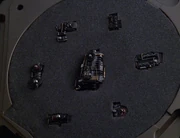
A set of Borg implants after removal
Upon assimilation, a drone would cease to grow body hair and would develop a pallid skin coloration, differing from its original skin pigmentation. Cybernetic implants were either surgically attached to the body or grown internally by nanoprobes injected into the bloodstream; in certain cases these implants could cause severe skin irritation. ( TNG : " The Best of Both Worlds "; Star Trek: First Contact ) The nature of these implants varied from drone to drone depending on the drone's intended function, but the basic nodes of interlink for communications with the Collective and a myo-neural cortical array to control movements were implemented in every drone. In most cases, an eye would be replaced with an eyepiece that improved its vision and an arm would be amputated altogether to make room for a functional prosthetic; in tactical drones, a weapon would be included, and some drones had medical tools built in to heal drones who had minor injuries. ( VOY : " The Gift ", " Dark Frontier ") The implants of a fully assimilated drone allowed it to function for extended periods without shelter, food, water, or even air. A drone could even survive in the vacuum of outer space. Lily Sloane , a human observer local to the Earth of the 21st century , characterized Borg drones as "bionic zombies " after hearing a description of them, albeit before observing them directly. ( Star Trek: First Contact )
A drone's only requirement was a supply of energy to maintain the implants that in turn maintained its biological functions. This energy was supplied during regeneration cycles within a Borg alcove . Upon receiving damage, a drone would return to the alcove for assessment of the damage. Severely damaged drones were disassembled and scavenged for reusable parts. ( TNG : " Q Who ", " I Borg ")
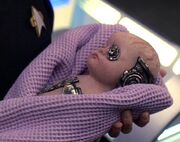
Infant Borg
The Borg did not procreate; they would add to the Collective's population only by assimilation. ( VOY : " Drone ") Borg infants were not accepted to the collective until they matured to a certain age. Until reaching this age, assimilated infants and youths were placed inside maturation chambers . ( TNG : " Q Who "; VOY : " Collective ")
Borg drones were equipped with myriad technologies integrated into their bodies which enabled them to perform their duties within the Collective, several of which were universal to all drones. A neural transceiver kept them connected to the hive mind . ( VOY : " Scorpion, Part II ") A personal force field protected each drone from most energy-based attacks. ( TNG : " Q Who ") A drone was able to communicate with their ship by signals across a subspace domain, the basis of their hive mind, which Data likened to a transporter beam . ( TNG : " The Best of Both Worlds, Part II ") Each drone possessed a pair of assimilation tubules embedded in one hand for the purpose of instantly injecting individuals with Borg nanoprobes. ( Star Trek: First Contact ) A cortical processor allowed a drone to rapidly assimilate visual information. Borg drones were also equipped with a neural processor, which kept a record of every instruction that particular Borg receives from the collective hive mind. Captain Picard used one such processor to discover that the Borg were attempting to use the deflector dish of the USS Enterprise as an interplexing beacon to contact the Borg in 2063. ( Star Trek: First Contact )
Drones also contained fail-safe mechanisms designed to deactivate and even vaporize their own bodies, thereby allowing the Collective to eliminate damaged or dead drones without leaving their remains to be exploited by outsiders. ( TNG : " Q Who ") The captured drone Third of Five also made comments indicating that this vaporization may have been a form of resource re-absorption. ( TNG : " I Borg ") One of these fail-safes was also intended to deactivate drones automatically if they experienced strong emotional states, which the Borg interpreted as a sign of disconnection from the hive mind. ( VOY : " Human Error ")
The Borg typically operated in an atmosphere with a constant temperature of 39.1 °C (102.38 °F ), 92% relative humidity, an atmospheric pressure of approximately 102 kPa , and trace amounts of tetryon particles. According to Amina Ramsey , the Borg smelled like old trash bags . ( LD : " Much Ado About Boimler ").
History [ ]
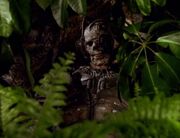
A Borg skeleton on a ruined planet
The precise origins of the Borg were unclear. As of 1484 , they were reported as controlling only a handful of systems in the Delta Quadrant , but by 2373 , they had assimilated thousands of worlds. In addition to this stronghold in the Delta Quadrant, the Borg also dispatched vessels throughout the galaxy via transwarp conduits . ( VOY : " Dragon's Teeth ", " Scorpion ", " Endgame ")
A Borg vessel traveled back in time from 2373 in an unsuccessful attack on Earth in 2063 . ( Star Trek: First Contact ) Drones which survived this defeat were discovered and reactivated by Human scientists in 2153 , and transmitted a subspace message to Borg space before being destroyed by Enterprise NX-01 . ( ENT : " Regeneration ")
The Borg entered the home system of the El-Aurians at some point in their mutual history, swarming through it, scattering its native inhabitants and leaving little to nothing of the El-Aurians in their wake. ( TNG : " Q Who ", " I Borg ") In 2293 , the Federation offered aid to the El-Aurian refugees fleeing the Borg. ( Star Trek Generations ) These refugees included Guinan , who would later provide secondhand knowledge of the Borg invasion of the El-Aurian system to the crew of the USS Enterprise -D during an encounter in the 24th century. ( TNG : " Q Who ", Star Trek Generations ) However, these earlier incidents contributed almost nothing to the Alpha Quadrant 's awareness or understanding of the Borg Collective.
By the 2340s , rumors of an alien race called "The Borg" had reached the Alpha Quadrant, inspiring exobiologists Magnus and Erin Hansen to set out in search of them. Their research took them all the way to the Delta Quadrant, before they and their daughter Annika were assimilated in 2350 . ( VOY : " The Gift ", " The Raven ", " Dark Frontier ") Borg activity in the Alpha Quadrant, including the assimilation of the USS Tombaugh in 2362 and assimilation of outposts along the Romulan Neutral Zone in 2364 , were complete mysteries to Starfleet. ( VOY : " Infinite Regress "; TNG : " The Neutral Zone ")
The Collective's true nature was finally revealed to the Federation in 2365 when Q took the USS Enterprise -D to meet a Borg cube near the J-25 system . ( TNG : " Q Who ")
In late 2366 , a Borg cube invaded Federation space and assimilated Jean-Luc Picard , whose tactical information contributed, along with the Borg's own vastly superior power, to Starfleet 's disastrously one-sided engagement with the cube, the Battle of Wolf 359 . A fleet of forty starships assembled to combat the cube. All but one of these Federation ships were destroyed, while the cube itself remained intact, damaged but healing rapidly. ( TNG : " The Best of Both Worlds ", " The Best of Both Worlds, Part II "; DS9 : " Emissary ") The Enterprise -D recovered Picard and used his connection to the hive-mind to disable the cube before it could attack Earth. ( TNG : " The Best of Both Worlds, Part II ")
During the 2370s , the Borg were beset by several major setbacks in the Delta Quadrant, as witnessed by the crew of the USS Voyager .
The Borg-Species 8472 War decimated the Collective from 2373 - 2374 . ( VOY : " Scorpion ", " Scorpion, Part II ") Voyager 's liberation of Seven of Nine allowed Unimatrix Zero to create an active resistance movement in 2377 . ( VOY : " Unimatrix Zero ", " Unimatrix Zero, Part II ")
In 2378 , a crippling blow was delivered to the Borg when Voyager discovered one of their transwarp hubs and destroyed it, killing the Borg Queen (again) and devastating the Unicomplex in the process. During this battle, the Borg were infected with a neurolytic pathogen , which was carried by an alternate future version of Admiral Janeway and designed to disrupt the hive mind, to 'bring chaos to order'. It was this pathogen that killed the Borg Queen and allowed Voyager to destroy the transwarp hub. ( VOY : " Endgame ") The pathogen decimated the Borg Collective, leaving them reduced a handful of drones slowly cannibalized to sustain the Queen's last remaining body by 2401 . ( PIC : " The Last Generation ")
In 2384 , a Borg cube rendered dormant by the neurolytic pathogen was encountered by the USS Protostar . The crew proceeded to venture into the cube in order to access the vinculum to gain information on how to remove a weapon called the living construct from their ship. When the Medusan Zero volunteered to be assimilated to get the information, this act caused the cube and the drones aboard to wake up. The crew barely managed to escape as they helped Zero to break free from the Collective, who then managed to put the Borg back to sleep. ( PRO : " Let Sleeping Borg Lie ")

The Borg emerge from Jupiter on Frontier Day, 2401
The Borg Collective was still believed to operate as late as 2399 . ( PIC : " Maps and Legends ") On Frontier Day in 2401, this was confirmed after discovery that the main faction of the Borg were working with the rogue Changelings in a plot to assimilate the Federation via a different means than normal. With the Changelings infiltrating the Federation and spreading Picard's Borg-altered DNA through the transporter system, the Borg were able to quickly gain control over 339 starships, and their crews with only those over 25 years old being immune to their takeover. ( PIC : " Võx ") This proved to be the last stand for the original Borg with the Cube, the Queen and all of her remaining drones being destroyed by the rebuilt USS Enterprise -D , presumably bringing an end to the Borg threat. ( PIC : " The Last Generation ")
In the far future , extant Borg assimilated into galactic society, with Borg children learning side-by-side with children of other species. ( LD : " Temporal Edict ")
Alternate timelines [ ]
Confederation of earth [ ].

Borg Singularity in 2401
In 2401 , an atypical Borg Queen reached out to Admiral Jean-Luc Picard seeking membership in the Federation. Much to the Federation's confusion, this Borg Queen was vastly different to the Queen that had been encountered before and her Collective wasn't nearly as outwardly hostile. However, once aboard the USS Stargazer , the Queen began assimilating the ship and through it, the Stargazer's fleet. In response, Picard activated the ship's auto-destruct , stopping the assimilation. ( PIC : " The Star Gazer ")
In that moment, Q had removed Picard, Agnes Jurati, Seven, Raffaela Musiker, Cristóbal Rios, and Elnor from this timeline, and placed them in an alternate 2401. In this timeline, the Borg had been hunted to extinction by the Confederation of Earth , leaving only the Borg Queen . ( PIC : " Penance ")

The Singularity and Federation vessels deflecting the energy burst
After being returned from 2024 to 2401 by Q , Picard deactivates the auto-destruct, having deduced that the strange Borg Queen was actually the Queen from this timeline that had merged with Dr. Agnes Jurati in 2024 and had set out to create a different Collective, one based on mercy and choice. These Borg had sought out the Federation's help to stop an energy wave that threatened countless lives and by combining the shields of the Federation fleet and the Borg ship, the two former mortal enemies were able to stop it. However, the Borg didn't know the source of the energy wave or the massive transwarp conduit that emerged from it, only that it was a threat to everyone. Picard granted the Borg Queen's request to grant the Borg provisional membership in the Federation so that the Borg could be "the Guardian at the Gates" watching out for whatever this new threat was. ( PIC : " Farewell ")
Parallel universes [ ]
Picard's death [ ].
In one alternate quantum reality , Captain Jean-Luc Picard was lost in the Battle of Wolf 359 and William T. Riker succeeded him as the captain of the Enterprise -D with Worf as his first officer . ( TNG : " Parallels ")
Victory over the Federation [ ]
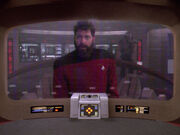
A disheveled Riker of a Borg controlled quantum reality
In another alternate quantum reality, the Borg, after emerging victorious at Wolf 359, successfully conquered the Federation. A battered Enterprise -D, which was likewise under Riker's command, was one of the few remaining Starfleet ships by 2370 . The Riker from that reality was desperate not to return to his universe once all of the Enterprises began spilling into a single universe from a quantum fissure .
After the present reality's Enterprise -D fired lightly upon the other ship to draw the alternate reality crew's attention away from that crew's attempt to prevent the closing of the fissure, the heavily damaged ship was accidentally destroyed when its shields collapsed and their warp core overloaded , due to having a weakened warp containment field , as Riker presumed, from fighting with the Borg. ( TNG : " Parallels ")
Borg-Earth [ ]

Borg-assimilated Earth
In another alternate timeline, the Borg were successful at preventing First Contact in 2063 and had assimilated the Earth. In 2373 , the assimilated Earth had an atmosphere containing high concentrations of methane , carbon monoxide , and fluorine . It had a population of approximately nine billion Borg drones . ( Star Trek: First Contact )
Culture [ ]

A trio of Borg drones, including one of Klingon origin
The Borg Collective was made up of, at the very least, trillions of humanoids referred to as drones. ( VOY : " Dark Frontier ") Through the use of their cybernetic implants, the Borg interacted by sharing one another's thoughts in a hive mind . Upon assimilation, these trillions of "voices" would overwhelm the drone, stifling individual thought and resistance to the Collective's will. ( TNG : " Family ") To some drones these voices could eventually become a source of comfort, and their absence a source of pain. ( TNG : " I Borg "; VOY : " The Gift ")
Borg philosophy was governed by a primary directive to add the biological and technological distinctiveness of other species to that of the Borg. In this manner, the Collective sought to achieve its definition of perfection; all other pursuits were deemed irrelevant including commerce and trade. Accordingly, Borg drones did not engage in any activities except their duties and regeneration . ( TNG : " Q Who ", " The Best of Both Worlds "; VOY : " Scorpion, Part II ") Individual drones have demonstrated puzzlement at other species' unwillingness to be assimilated, the drones believing in the superiority of their way of life.
Having no regard for individuality, Borg drones were identified with designations rather than names. A drone's designation typically described its position within a group, e.g. " Third of Five ." To identify a drone more specifically, its function could be appended to this designation, for example " Seven of Nine , Tertiary Adjunct of Unimatrix 01 ." In the same manner, the Borg referred to alien species by number rather than by name. ( TNG : " I Borg "; VOY : " Scorpion ")
If a drone was sufficiently injured or otherwise in distress, other drones would offer assistance. ( TNG : " I Borg "; VOY : " Dark Frontier ") However, if a drone was deemed irreparable by the hive-mind, the Borg would deactivate it and redistribute any salvageable components throughout the Collective. ( TNG : " Q Who ")
Borg drones ignored alien species until they demonstrated the potential to be a threat, or to be a suitable candidate for assimilation. This indifference even extended to their attitude to people boarding their vessels; the drones went about their business as long as the intruders did not interfere. When addressing a small number of individuals, drones would simply attempt to assimilate them without comment. Before assimilating a larger population, such as a starship or an entire culture, the Borg would collectively transmit a standard announcement of their purpose and the futility of resistance. ( TNG : " Q Who "; VOY : " Dark Frontier "; Star Trek: First Contact ) Species which the Borg found unremarkable or detrimental would be deemed unworthy of assimilation. As of 2374 , the Borg considered the Kazon beneath their notice, and by 2376 , they only took interest in the Brunali if they detected sufficiently relevant technology. ( VOY : " Mortal Coil ", " Child's Play ")
Even examples of civilizations which had previously been targeted for assimilation could be passed over; while moving to engage the dire threat to the Borg presented by Species 8472 , a group of Borg ships encountered Voyager , but, while one ship did pause momentarily to scan the Federation vessel, the Borg ship and its companion ships quickly moved on without attempting to attack or assimilate the interloper in their space. ( VOY : " Scorpion ")

Representatives of the Collective: Locutus with the Borg Queen
On the rare occasions that the Borg were willing to open any dialogue with individuals, they would choose a single drone to speak for the Collective. Jean-Luc Picard was assimilated and given the name Locutus in the misguided assumption that such a representative would lower the Federation's resistance to assimilation. ( TNG : " The Best of Both Worlds ")
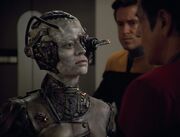
Seven of Nine speaks for the Collective
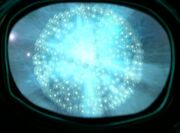
The Omega molecule
When Kathryn Janeway successfully negotiated a truce with the Borg and refused to discuss the terms via a neuro-transceiver , the Collective agreed to communicate via Seven of Nine. ( VOY : " Scorpion, Part II ")
The Borg Queen also spoke for the Collective, acting not as a mere liaison, but as a physical manifestation of the hive mind. The exact nature of her role is unclear. ( Star Trek: First Contact )
The Borg possessed a near-reverence for particle 010 , which they considered to be an expression of perfection. The Collective's fascination with assimilating this molecule has been compared to a religion. ( VOY : " The Omega Directive ")
Tactics [ ]
The Borg had a tendency to "scoop" all machine elements from a planet, leaving great rips in the surface where remaining sections of the road system suggested a city had once been. ( TNG : " The Neutral Zone ", " Q Who "; VOY : " Child's Play ")
The Borg were known to retrieve their own damaged technology, including nonfunctional Borg cubes. However, when a cube underwent submatrix collapse , the collective would immediately sever its link to the afflicted population, considering it dead. ( VOY : " Unity "; PIC : " Maps and Legends ")
Technology [ ]
Borg technology was a combination of technologies assimilated from other cultures, and technology developed within the Collective itself, in order to overcome obstacles to its goals. When confronted by a problem it could not solve with its existing resources and/or configuration, the entire Collective would work in concert to consider all possible solutions, and implement the one determined to be the most efficient. By applying the unique skills of each drone to a task, the hive mind could engineer new technologies and solutions at a pace that would astound an individual. ( TNG : " Q Who ", " The Best of Both Worlds, Part II ")
The Borg were usually exceedingly quick to adapt; their shields would often nullify nearly any energy weapon, and their weapons could usually penetrate nearly any shield or defense, within minutes. ( Star Trek: First Contact )
Spacecraft [ ]
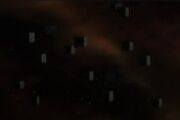
Borg cubes, arguably their most iconic ship design
Borg vessels were highly decentralized, with no distinct bridge , living quarters, or engineering section. Each ship was collectively operated by its complement of drones, under the general direction of the hive mind. Owing to the Collective's disregard for aesthetic considerations, the architecture of Borg ships took the form of basic shapes such as cubes and spheres and were made from a tritanium alloy. Borg ships were capable of regenerating from damage. ( TNG : " Q Who "; VOY : " Endgame ")
Each Borg spacecraft was equipped with a vinculum to interconnect its crew, which was in turn connected to a central plexus that linked the ship to the Collective. ( VOY : " Infinite Regress ", " Unimatrix Zero ") In addition to warp drive , vessels were fitted with transwarp coils that could achieve even greater speed by opening transwarp conduits . ( TNG : " Descent "; VOY : " Dark Frontier ") When critically damaged or otherwise compromised, a Borg ship would self-destruct to prevent outsiders from studying Borg technology. ( TNG : " The Best of Both Worlds, Part II ") In other situations, only the valuable technology would self-destruct, such as the case of the crew of Voyager's first attempt to steal a transwarp coil. USS Voyager encountered several damaged Borg vessels, notably including the cube carrying Icheb , Mezoti , Azan , and Rebi , and a sphere carrying a transwarp coil, which Voyager stole. ( VOY : " Collective ", " Dark Frontier ")
Infrastructure [ ]
Borg structures were located in deep space, in planetary systems, or on planets themselves. Each planet that the Borg modified showed a typical climate and assimilated infrastructure adapted from the previous inhabitants. ( Star Trek: First Contact ; VOY : " Dark Frontier ", " Dragon's Teeth ")
Their buildings consisted of simple shapes, similar to their geometrical ships, and rather than being single structures they were annexed together and added to when needed. By joining the new structures to existing ones, they would form a uniform complex. These buildings were gargantuan in scale, with structures so big that they could house Borg spheres which would dock inside. ( VOY : " Dark Frontier ")
The Borg also constructed structures that had specific functions, such as the transwarp hub . There were six such known hub locations in the galaxy that allowed Borg vessels to deploy rapidly to almost everywhere within it. These transwarp hubs had many structures for opening portals on them, and inside their corridors were interspatial manifolds which supported the transwarp conduits . Several of these manifolds that led to the Alpha quadrant were destroyed by Voyager via transphasic torpedos and collapse of the conduit itself on the vessel's return to the Alpha Quadrant . ( VOY : " Endgame ")
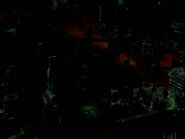
Appendices [ ]
See also [ ].
- Borg Collective
- Borg language
- Borg philosophy
- Borg spatial designations
- Borg species
- Borg species designations
- Borg starships
Appearances [ ]
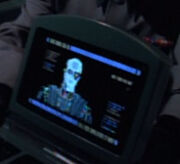
A Borg in the database of Voyager
- " The Best of Both Worlds "
- " The Best of Both Worlds, Part II "
- " Descent "
- " Descent, Part II "
- DS9 : " Emissary "
- Star Trek: First Contact
- " Blood Fever "
- " Scorpion "
- " Scorpion, Part II "
- " The Raven "
- " The Killing Game "
- " Living Witness "
- " Hope and Fear "
- " Infinite Regress "
- " Dark Frontier "
- " Survival Instinct "
- " Tinker Tenor Doctor Spy "
- " Collective "
- " Child's Play "
- " Unimatrix Zero "
- " Unimatrix Zero, Part II "
- " Imperfection "
- " Flesh and Blood "
- " Shattered "
- " Endgame "
- ENT : " Regeneration "
- " Remembrance "
- " Maps and Legends "
- " The Impossible Box "
- " Broken Pieces "
- " The Star Gazer "
- " Penance "
- " Assimilation "
- " Watcher "
- " Fly Me to the Moon "
- " Hide and Seek "
- " Farewell "
- " The Last Generation "
- " Envoys " (holograms)
- " Temporal Edict "
- " Crisis Point " (hologram)
- " I, Excretus " (holograms)
- " wej Duj "
- PRO : " Let Sleeping Borg Lie "
Background information [ ]
Concept and development [ ].
The conceptual genesis of the Borg, who were intended to replace the Ferengi as Star Trek: The Next Generation ' s main villains in its second season, was as a race of insectoids , an idea that would ultimately require modification due to the series' budgetary constraints. As Maurice Hurley explained in the March 1990 issue of Starlog (#152, p. 33): " What we really wanted to do, but couldn't because of money, was create a race of insects...insect mentality is great because it is relentless. The Borg are a variation of an insect mentality. They don't care. They have no mercy, no feelings toward you. They have their own imperative, their own agenda and that's it. If all of them die getting there, they don't care. We needed a villain who could make you dance, and the Borg could do it! "
Hurley made it a plot point in " The Neutral Zone " that Federation and Romulan starbases along the Romulan Neutral Zone had been mysteriously wiped out, having been "scooped off" the face of the planet in the same way that would later be referenced in " Q Who " and shown in " The Best of Both Worlds ". Intentions to lay more extensive groundwork for the Borg's introduction were frustrated by the Writer's Guild strike of 1988 . By the time of their first appearance in "Q Who", the species had been changed from insects to their more budget-friendly cyborg form. ( Captains' Logs: The Unauthorized Complete Trek Voyages , pp. 169 & 180)
The Star Trek Encyclopedia (3rd ed., p. 52) stated: " Writer Maurice Hurley derived the name Borg from the term cyborg (cybernetic organism), although it seems unlikely that a people living on the other side of the galaxy would know of the term. "
According to Michael and Denise Okuda in their Star Trek Chronology (2nd ed., p. 290), there had been plans to connect the parasitic beings from " Conspiracy " to the Borg, but these were ultimately abandoned: " At the time the episode was written, this was apparently intended to lead to the introduction of the Borg in Star Trek: The Next Generation' s second season. The Borg connection was dropped before 'Q Who?' (TNG) was written, and the truth about the parasites remains a mystery. " They also noted that, following production of the latter episode, it was "half jokingly speculated" by Gene Roddenberry that the machine planet encountered by Voyager 6 , leading to its transformation into V'ger , "might have been the Borg homeworld." ( Star Trek Chronology (2nd ed., p. 23))
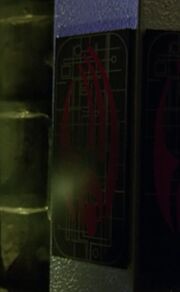
A Borg insignia
The Borg insignia, which first appeared in "Q Who", was described on its own Star Trek: The Next Generation - Inaugural Edition trading card (82-A) as " Resembling a great red claw over a background of circuitry, the symbol of the Borg is as mysterious as the race it represents. The Borg symbol may possibly define an amalgam of living tissue with computer circuits... " [2]
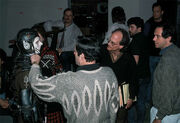
Westmore's Borg make-up is reviewed for "Q Who"
Michael Westmore revealed that the Borg actors were glued into their suits, and had to be unglued if they needed to use the bathroom. [3]
The idea for the sound of the Borg's multiple voices speaking in unison was thought up by sound editor Bill Wistrom and co-producer Merri Howard . After experimenting with different techniques, they discovered a way to lay multiple voices over one another and "make it sound like it was 8 million people," explained Wistrom. ( Star Trek: Communicator issue 147 , p. 32)
Chronologically, the first known in-universe appearance of the Borg to Humanity was in the 1996 motion picture Star Trek: First Contact , in which the Borg traveled back to the year 2063 to enslave the Human race. The writers of the Star Trek: Enterprise episode " Regeneration ", Michael Sussman and Phyllis Strong , stated, in the audio commentary on the ENT Season 2 DVD release, that it was their explicit intent to have the episode deal with the consequences of events depicted in Star Trek: First Contact , the Borg wreckage encountered in that episode being the debris of the Borg sphere destroyed by the Enterprise -E in that movie.
While it is not explicitly stated in "Q Who", Q implies that the sole focus of the Borg is on the technology of the USS Enterprise -D, and the Borg show no interest, in that episode, in the crew (although the segment of hull that the Borg remove from the ship apparently contained several crew members). By their next appearance, "The Best of Both Worlds", the Borg's objectives had changed to the assimilation of lifeforms, and this change of premise was referenced in dialogue. Subsequent episodes ignored the change in premise entirely.
Director Cliff Bole , who directed the "Best of Both Worlds" two-parter, thought highly of the Borg. He enthused, " The Borg are like Klingons. You can do anything you want with them. They're fun and a real expensive thing to play with. With them, you can do a big production value [...] The Borg allow you to have fun with the camera, the lighting and everything else. They challenge the imagination. " ("Cliff Bole – Of Redemption & Unification", The Official Star Trek: The Next Generation Magazine issue 17 , p. 31)
Through the course of Star Trek history, further retroactive continuity changes appear to have been made in respect of the Borg. As of "Q Who" and "The Best of Both Worlds", it appeared that Starfleet had never heard of the Borg. Subsequently, Star Trek: Voyager s " Dark Frontier " and Star Trek: Enterprise s " Regeneration " showed that not only was Starfleet previously aware of the existence of the Borg, Federation scientists actually pursued them – even if they were considered mere rumor. Further, although Guinan indicates in "Q Who" that her people were attacked by the Borg, it is implied that Starfleet was not aware of the threat. However, it was later revealed in Star Trek Generations that Starfleet, in fact, rescued the El-Aurian survivors of the Borg attack including Guinan, and it seems unlikely that Starfleet would not inquire as to the cause of their plight.
The existence of the Borg Queen was a controversial change made to the Borg during the writing of Star Trek: First Contact . While the writers had intended to stay true to the original concept of the Borg as a collective hive, they found it difficult to maintain the dramatic impact of villains without having a central face. Thus, they created the Queen. In the film, she claimed to have been present during the events of " The Best of Both Worlds ", which in retrospect would appear to have negated the reason for Picard's assimilation in that episode (it was claimed that the Borg needed a single representative to speak for them). While the Queen appeared to be killed at the climax of First Contact , she apparently survived unaffected by the Borg's next appearance in Voyager 's " Scorpion ". While many fans have attempted to reconcile this, there has never been an official explanation for her survival (save for an enigmatic comment by the Queen), and the appearance of relatively identical Borg Queens in later episodes. Some, though, have theorized that the Borg Collective contained many queens that served as focal points to different branches of their society. Still another explanation is that the Borg were in possession of innumerable copies of their Borg Queen, and that the superficial death of one version simply resulted in the activation of a similar version to take her place, in a similar fashion to the Vorta . The latter theory was corroborated by Rick Berman in an interview in Star Trek: Communicator . ( Star Trek: Communicator issue 121 )
Impact and legacy [ ]
The Borg were considered as an enemy for the Deep Space 9 crew (along with the Klingons , Cardassians , and the Romulans ) when Star Trek: Deep Space Nine was in development. Rick Berman later commented, " The Borg are not the kind of bad guys that are practical to use on a regular basis. " Whereas the Cardassians were eventually chosen for the main villain role, the Borg made no further appearances in Deep Space Nine after " Emissary ", although they were mentioned in episodes such as " The Storyteller ", " Playing God ", " The Search, Part I ", " The Way of the Warrior ", " For the Cause ", " Let He Who Is Without Sin... ", and " In Purgatory's Shadow ". ( Star Trek - Where No One Has Gone Before ) According to Robert Hewitt Wolfe in a tweet dated 28 January 2019, following the premiere of Star Trek: Voyager , a mandate was passed to the writing staffs of both Deep Space Nine and Voyager that the Borg (along with Q, following his single appearance on Deep Space Nine ) were only to be used on Voyager while Deep Space Nine retained creative control over the Alpha , Beta , and Gamma Quadrants , which Wolfe called "a fair trade." [4]
The Borg were considered by some commentators to be the greatest villains of Star Trek: The Next Generation . However, they were featured in only six episodes throughout its seven-year run. The creators have stated that this was due to the fact that the Borg were so powerful, and so it was not easy to come up with solutions for beating them. However, as time passed and future series went into production, the concept of the Borg evolved to include inherent flaws that could be exploited in many different ways – leading them to appearing in nineteen episodes of Star Trek: Voyager (although in only a fraction of these appearances were the Borg the primary villains; many episodes had them in supporting or otherwise non-antagonistic roles). This generous use caused many fans to complain that the Borg were being used too often on Voyager . TNG, DS9, and one-time VOY writer Ronald D. Moore once said of their perceived overuse, the Borg had been defeated so many times, that they had "lost their teeth." ( citation needed • edit )
Following "Regeneration" and the season it was in, ENT Season 2 , Brannon Braga stated, " We have no plans to see the Borg ever again. " ( Star Trek: Communicator issue 145 , p. 30)
In 2006 , the Borg were honored with their own DVD box set Star Trek: Fan Collective - Borg , featuring a number of their more memorable appearances in the Star Trek universe.
In an interview with StarTrek.com published on 1 April 2019, the actor Alan van Sprang , who played Leland in Star Trek: Discovery , echoed fan speculation regarding a potential connection between Control and the origins of the Borg: "I think it's very intriguing. When I first read the script I thought, 'Oh, is this the making of the Borg? Is that how it happens?' We're as much in the dark as anybody else, but as soon as I saw that, I thought, 'This is like The Borg.' The Next Generation' s Borg episode just blew my mind [when I watched it originally], let alone when Picard became Locutus . That's the first thing I thought of, which kind of tickled me to no end. 'Wow, I'm just going to milk this for all it’s worth.'" [5]
In an interview with TrekCore.com published on 19 April 2019, Michelle Paradise , then writer and co-executive producer of Discovery , clarified: "It's interesting — we weren't thinking Borg at all. I mean, we talked about all sorts of different things in the room, but there was never any intent on our part to parallel that in any way. I can certainly understand why people started to think we were going in that direction, but it was never where we intended to go with it." [6]
In an Instagram story dated 12 March 2020, Michael Chabon , then showrunner of Star Trek: Picard , opined of the same theory: "It has the virtue of making sense. But I don't think it's much fun." [7]
Apocrypha [ ]
The absence of the Borg from Deep Space Nine was explained in the novel The Siege , when a Borg cube tries to pass through the Bajoran wormhole and is destroyed by subspace compression; Sisko concludes that this event will cause the entire Collective to believe that the wormhole is unstable and would now avoid it.
In the alternate timeline seen in the Star Trek: Deep Space Nine book series Millennium , the Borg forged an alliance with the Federation to defeat Weyoun . The entire Borg Collective was destroyed along with the universe. This entire timeline was later reset thanks to Benjamin Sisko.
In an alternate timeline in the game Star Trek: Armada , the Borg succeed in conquering the Alpha Quadrant. Using a clone of Locutus, the Borg manage to assimilate Spock , kill Worf, and assimilate Earth. The timeline was reset thanks to Jean-Luc Picard and the crew of the Enterprise -E, who travel back in time with the aid of a ship from the future to prevent Spock's capture.
In the game Star Trek: Legacy , an alternate explanation was given to the creation of the Borg which states that the probe V'ger created the Collective to serve as its heralds in its search for knowledge. However, the creation of the Borg Queen resulted in the creation of an entity that abandoned the original intent of V'ger . This is also similar to the Shatnerverse version of events.
In the current volumes of the Next Generation Relaunch series of novels, the Borg have been driven to near extinction as a result of the Starship Voyager 's destruction of the Queen and the transwarp conduit network. However, they begin to reconstruct the Collective by building a massive cube in the Alpha Quadrant, in order to launch a vengeful new offensive against the Federation; their first strike results in the assimilation of Admiral Janeway and the destruction of Pluto before the Enterprise -E manages to destroy the cube with the original Doomsday Machine .
In Star Trek: Destiny a history of the Borg was presented. They were survivors of the Caeliar Gestalt and the crew of the Earth ship Columbia NX-02 thrown back in time and into the Delta Quadrant following an attack on a Caeliar city ship. The Caeliar forced the Humans into a perverted form of their Gestalt (a mental linking of the Caeliar) based upon the will of the last surviving Caeliar and not the whole. They launched a final attack of Federation space with over 7,000 cubes at their disposal; however, they were stopped after the Caeliar were made aware of their responsibility for the Borg's actions. The Collective was dismantled, and the assimilated Borg drones were accepted into the Caeliar's gestalt. Former drones fully regained their individuality (as evidenced by Seven of Nine's remaining implants dematerializing). This was followed up in the novel Full Circle . Q later noted that this timeline's invasion was provoked by Admiral Janeway's trip to the past in " Endgame ", reflecting that, if she had done nothing, the Borg would have eventually launched a massive assault on the Milky Way galaxy centuries in the future that would have completely assimilated all other life. The Voyager relaunch novel Unworthy explores the aftermath of the destruction of the Borg, including some Federation scientists trying to harness remaining Borg technology and Voyager encountering a vast fleet called the "Indign" consisting of species who actually wanted to be assimilated but were considered unworthy of that "honor" by the Borg.
In the Star Trek: The Original Series short story "The Trouble with Borg Tribbles" from the anthology book Strange New Worlds V , a Borg cube encountered a pod full of Tribbles which had traveled through a micro-wormhole from the Alpha Quadrant in early 2268 . This was the Borg's first contact with life from that part of the galaxy. The Borg assimilated the surviving Tribbles, only to find that their instinctive drive to eat and procreate was starting to overwhelm the hive mind, causing a widespread series of malfunctions.
The comic book series Star Trek: Countdown shows that Nero 's ship, the Narada , was enhanced with a mixture of Romulan and Borg technology. The sequel miniseries Star Trek: Nero has the Borg, the Narada and V'ger originating from an unknown civilization on the " machine planet " that was seen inside V'ger in Star Trek: The Motion Picture .
The Star Trek: The Manga story "Side Effects" in Shinsei Shinsei provided a different story to the creation of the Borg, with an experiment gone wrong to save a race through the daughter of one of the 1,000 or so survivors. Cybernetic implants, along with DNA from nine different species designed to keep a disease from spreading caused the girl to go insane and gain a twisted idea of saving her people. However, the intervention of Captain James T. Kirk made the situation even worse, as the laboratory where she was augmented collapsed and was sucked into a black hole . But an escape pod with the girl was launched, and apparently catapulted far into the past by the slingshot effect , where her cybernetic implants and DNA evolved to where she became the very first Borg Queen.
In the game Star Trek Online , the Borg have resurfaced after thirty years and have conquered several Federation sectors, including the Mutara sector . The Borg of 2409 look much more like zombies, with some of their cybernetic implants looking like bones coming out of their bodies.
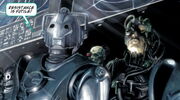
The Cybermen and the Borg
The comic book crossover series Star Trek: The Next Generation - Doctor Who: Assimilation² involves a plotline in which the Cybermen of the Doctor Who universe alter time and space in order to form an alliance with the Borg. The united cyborg force proves to be a devastating threat to the Federation, but the two races end up turning against each other, with the Cybermen going to war with the Borg and forcing the crew of the Enterprise -D and the Eleventh Doctor and his companions to ally with the Borg to restore the Collective and vanquish the Cybermen. At the end of the series, the Borg start to investigate time travel in order to find a way to assimilate the Doctor.
In The Delta Anomaly , a book set in the alternate reality created by the Romulan Nero 's attack on the USS Kelvin , the serial killer known as The Doctor ( β ) is suggested to be related to the Borg. This therefore establishes an earlier contact with Earth than in the prime reality.
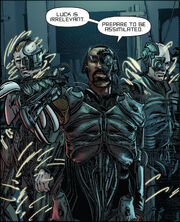
The Borg of the alternate reality
In Star Trek: Boldly Go , a comic series also set in the alternate reality and after the events of Star Trek Beyond , the Borg make an appearance as the villain in the first arc of the series, seeking the Narada due to their awareness of its ties to the Borg. They attempt to assimilate Spock , but the primitive assimilation of this era is unable to cope with his hybrid DNA. The shock of his escape and the retrieval of other near-assimilated officers enables the Federation and the Romulans to destroy the Borg.
External links [ ]
- Borg at Memory Beta , the wiki for licensed Star Trek works
- Borg at Wikipedia
- 1 Abdullah bin al-Hussein
Memory Beta, non-canon Star Trek Wiki
A friendly reminder regarding spoilers ! At present the expanded Trek universe is in a period of major upheaval with the continuations of Discovery and Prodigy , the advent of new eras in gaming with the Star Trek Adventures RPG , Star Trek: Infinite and Star Trek Online , as well as other post-57th Anniversary publications such as the ongoing IDW Star Trek comic and spin-off Star Trek: Defiant . Therefore, please be courteous to other users who may not be aware of current developments by using the {{ spoiler }}, {{ spoilers }} OR {{ majorspoiler }} tags when adding new information from sources less than six months old (even if it is minor info). Also, please do not include details in the summary bar when editing pages and do not anticipate making additions relating to sources not yet in release. THANK YOU
- Memory Beta articles sourced from video games
- Memory Beta articles sourced from games
- Memory Beta articles sourced from episodes and movies
- Memory Beta articles sourced from novelizations
- Borg Collective
- Political titles
- Time travellers
- View history

The Borg Queen.
The Borg Queen is the apparent leader of the Borg Collective . Throughout the history of the Borg there have been a number of queens who seem to take on the same character, perhaps indicating the Queen is a persona within the collective which could, in theory, occupy any number of different drone bodies.
- 1.1.1 The beginning
- 1.1.2 Side effects
- 1.1.3 Legacy
- 1.1.4 Destiny
- 1.2 Purpose
- 1.3.1 First Splinter timeline
- 1.3.2 Other alternate realities
- 3.1.1 Appearances
- 3.2 External link
Biography [ ]
Creation [ ].
There are a number of accounts as to how the Borg Queen came into being. Due to time loops and temporal revision resulting from time travel and causality, it is difficult to determine a linear order for which origin might have preceded the others.
The beginning [ ]
The Borg Queen was subject of a world that had been struck down by a deadly disease, which was slowly killing much of the population. The scientists on the planet developed bio-organic regenerators , a nanotechnology which would be injected into a subject's circulatory system, eradicate the disease and rebuild the patients crippled body. The Queen to be, in very ill health, was selected to be the subject of the first experiment. It was successful in eliminating the disease but also began to change her, making her stronger than ever before, replacing her broken body with technology and giving her drive and determination to share her gift with others and make them as perfect as her superior self had become. The establishment attempted to resist but the Queen was not willing to let herself be destroyed and instinctively used the nanoprobes to assimilate others. She quickly led her drones in assimilating the entire planet and set to work to spread her gift to the rest of the galaxy. ( Strange New Worlds VI short story : " The Beginning ")
Side effects [ ]
Alternatively: The Borg Queen was originally a woman named Danzek , (or Asil *), who was the daughter of a scientist named Mynzek . Mynzek, with the aim of finding a cure for a terrible disease established a research base near the event horizon of a black hole . He sent ships out via a series of wormholes to capture subjects and run experiments on them in the search for a cure. Using the gravitational time dilation effect of the black hole he could coordinate centuries of research being conducted on the ships, which for those on the base took only days. Danzek was the guinea pig for these experiments on one ship, integrated with technology and biological components from numerous races she became powerful and returned to the station controlling a group of drone-like test subjects. After a brief confrontation in which the station was destroyed, Danzek, queen of her subjects escaped through a wormhole, which thanks to the temporal distortion generated by the exploding station could have sent here anywhere in space and time. ( TOS comic : " Side Effects ")
The Vulcan Commander T'Uerell engaged in a mind meld with the Borg and discovered that the Collective was created by the probe V'Ger to serve as its heralds. During the Collective's development, it was discovered that females of certain species possessed a mental prowess and were capable of sifting through the endless amounts of information. These would become the first Borg Queens. However, the development of the Queen resulted in an entity that sought its own objectives and eventually abandoned the goals set forth by V'Ger. ( ST video game : Legacy )
Destiny [ ]
A species known as the Caeliar lived on the planet Erigol , having long ago harnessed claytronic atoms , programmable matter able to be controlled via a hive mentality . The Caeliar dedicated their lives to a Great Work , hoping to find the next evolutionary step for them. However, a deliberately malicious feedback pulse destabilized their Work and their solar system, forcing the evacuation of their cities. One of the cities, Mantilis was thrown through a subspace tunnel into the far past . The few Earth Starfleet officers who survived decided to make their living separate from the Caeliar, but were eventually forced to return. One Caeliar remained alive, Sedín , who merged with the three remaining humans, one of whom was Kiona Thayer who became the precursor to the first Borg Queen. ( ST - Destiny novels : Gods of Night , Lost Souls )
The Borg Queen who succeeded in traveling back to 2063 and assimilating Earth had no memory of the name Sedín when confronted by the Jean-Luc Picard of the First Splinter timeline , indicating this origin was specific to only that reality, or possibly that circumstances had caused memory of that to be purged from her alternate timeline version of the Collective. ( ST - Coda novel : Oblivion's Gate )
Purpose [ ]
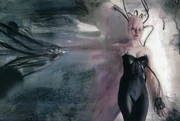
Borg Queen connectivity.
The Queen appears to lead the Borg, having total control over the entire Collective, however it is possible she acts as a figure head, a voice for the Collective, much like Locutus . When it appears she is ordering the Collective she may simply be enacting the Collective's will. As the Queen is also part of the collective it may be possible she stands in the mid ground, part of Collective decision but filtering out the best ideas herself, bringing "order to chaos". ( TNG movie & novelization : First Contact , et al.) Should the Borg Queen die, any drones under her command would be forced to enter hibernation. ( TNG video game : Armada II )
History [ ]

For years, the Queen selected industrial age worlds and did not assimilate them, but instead gave a select few on these planets technology, advancing the cultures dramatically over a small time period. Among these inhabited worlds were those of Species 642, Narisia , and 1429, a planet which later developed methods of traveling through time in starships. When either the species made significant progress towards something useful or lost their usefulness to her purposes, the Queen severed the assistance and cut off their links. ( ST novel : Engines of Destiny )
In 2367 , the Borg Queen was aboard a Borg cube that was sent to assimilate the planet Earth . Starfleet attempted to amass a fleet at Wolf 359 , which was devastated using the knowledge gained from Locutus of Borg , the assimilated form of USS Enterprise -D Captain Jean-Luc Picard . Although the cube was destroyed over Earth, the Queen was able to escape, either in body or mind, and was present when the Borg again attempted to assimilate Earth in 2373 . This time, the USS Enterprise -E and the USS Defiant were among the fleet that destroyed the cube in the Sol system. The Enterprise -E was drawn into a temporal vortex as a Borg sphere attempted to travel back in time so that the Queen could warn herself of the resistance put up by the fleet. Instead, the time travel technology threw the sphere and Enterprise back to 2063, where the Starfleet crew was able to prevent the Borg from assimilating the Enterprise and Earth, preventing the warp drive that led to the first contact between Humans and Vulcans . ( TNG episode : " The Best of Both Worlds ", TNG movie : First Contact ; ST novel : Engines of Destiny )
In an alternate timeline where Montgomery Scott rescued James T. Kirk before he could be absorbed into the Nexus , the Enterprise -E did not exist, and thus the Queen traveled back in time and was not defeated as before. She and her drones assimilated Earth, erected a sensor barrier around the Sol system, and then methodically proceeded to assimilate surrounding worlds; she also reactivated links to her subject worlds. However, a time traveling Enterprise -D wound up in 2293, which the Queen became aware of through a Narisian named Balitor . The Queen possessed her body and attempted to attack and kill Picard, but was unsuccessful, and she terminated all Narisians linked to the Collective. The Queen was able to then control a Borg cube and eventually destroy the Enterprise , but her existence and that of her timeline ceased to exist when Picard was able to return Kirk to the Nexus. ( ST novel : Engines of Destiny )
By 2375 the Borg Queen was a member of Species 125 . ( VOY episode : " Dark Frontier ")
First Splinter timeline [ ]
The First Splinter timeline which diverged from the " prime" version of reality in the 2380s decade would see two different Queens, perhaps owing to causality of some notable time travel events. The first was created aboard a Borg Cube in Sector 10 . The creation process was, however, halted by the crew of the USS Enterprise -E a short time after coming online. ( TNG novel : Resistance ) Later, the Borg would capture and assimilate Admiral Kathryn Janeway - making her into a replacement Queen. She would be destroyed after being infected by Project: Endgame. ( TNG novel : Before Dishonor )
A new Borg Queen was created, and as soon as she emerged from her chrysalis, she had two objectives - destroy Earth and crush the Federation. Since the Borg believed that they could no longer gain anything by assimilating Earth, they would instead destroy it; thus, the Collective launched their invasion in 2381 , and the new Borg Queen utilized the connection to the former drone Locutus to taunt him. She also oversaw the invasion forces, moving between vessels and not allowing former drone Seven of Nine to lock onto her position. Due to the former Earth Starfleet Captain Erika Hernandez being infused with Caeliar catoms , she was able to listen in on the Borg Collective and locate the Queen as she led an armada to attack the planet Deneva . Noting the similarities between the voice of the collective and the Caeliar gestalt , Hernandez and the USS Aventine attacked and boarded a Borg scout craft to secure its vinculum to control the Collective via Hernandez. Although Hernandez was able to cause the collective to turn on itself for a short period, the Queen transferred her presence to that ship and assaulted the remaining crew, and regained control of her forces, causing them to sleep and regenerate quickly. After the Caeliar city ship of Axion came to the Azure Nebula to lure the invading Borg Collective there with its Omega molecule generator , the Queen overrode all other objectives and had the entire fleet move to the nebula. Once there, Hernandez presented herself for assimilation to act as a link between the Caeliar and the Queen, allowing them to reach past and find the remains of Sedín, which they dissolved along with the Collective. ( ST - Destiny novels : Gods of Night , Mere Mortals , Lost Souls )
Other alternate realities [ ]
A Borg Queen in an alternate reality created by changes made to history by Q in the 2020s decade was encountered by Jean-Luc Picard . This Queen was coerced into assisting Picard's crew into creating time travel computations to undo Q's meddling. She died in the past, in 2024 , but lived on through a mental link with Agnes Jurati , who became assimilated as a new Queen who would be encountered by Starfleet in the year 2400. ( Star Trek: Picard season 2 )
Appendices [ ]
Appearances and references [ ], appearances [ ].
- Star Trek: First Contact
- Star Trek First Contact (Marvel 1996)
External link [ ]
- Borg Queen article at Memory Alpha , the wiki for canon Star Trek .
- 1 The Chase
- 2 Ferengi Rules of Acquisition
- 3 Preserver (race)
Star Trek: Picard just permanently changed the timeline and there’s no going back
How many different Borg Queens are alive in 2024?
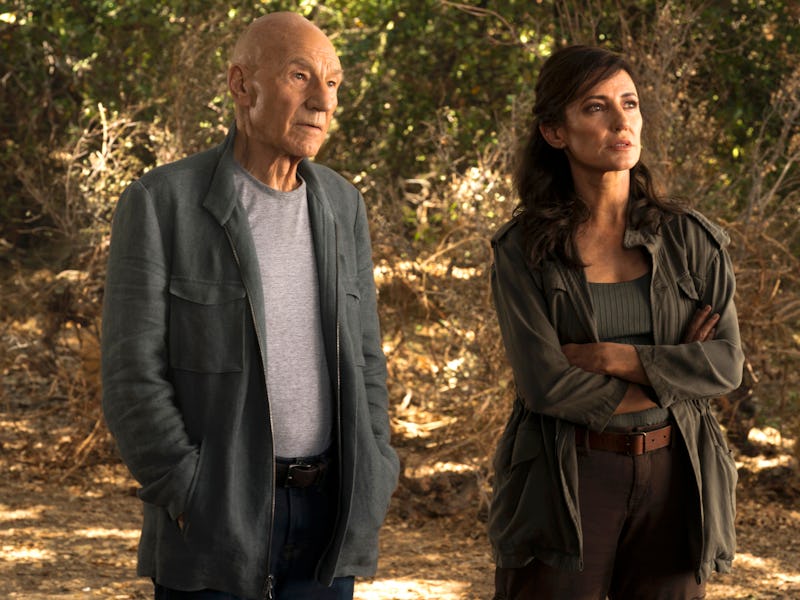
The Borg Queen is loose in the 21st century. At the end of Star Trek: Picard Season 2, Episode 9, “Hide and Seek,” Jean-Luc and what’s left of his motley crew are still trapped in the past, but now with a new timeline-altering wrinkle. Although we saw an alternate future back in Episode 2, the change in this episode is a much bigger deal. Here’s why the ending of Episode 9 seems to permanently alter Star Trek history. Spoilers ahead.

Jurati and Dr. Soong in Picard Season 2, Episode 8, “Mercy.”
Jurati creates a new kind of Borg
After merging with the Borg Queen (Annie Wersching) from an alternate 2401, Agnes Jurati (Alison Pill) is now a new kind of Borg Queen. But, pivotally, Jurati wins an internal debate with the Queen’s consciousness in her own mind. She convincingly proves that in every timeline the Borg are defeated, either by “a lone Borg slayer or a United Federation.” This references a couple Borg defeats in Trek canon: Their defeat and the Queen’s demise in First Contact , as well as Admiral Janeway’s defeat of the Borg — and another Queen’s destruction — in the Voyager episode “Endgame.”
Jurati convinces the Borg Queen that the only way forward for the Borg is to change and, essentially, become a nicer hivemind. As teased by Alison Pill , this reformed version of the Borg will become a voluntary collective. While there’s been rogue Borg before, there’s never been a Collective led by a Queen with the stated goal of optional assimilation. It’s new and exciting, and it’s a subtle change to Star Trek history.
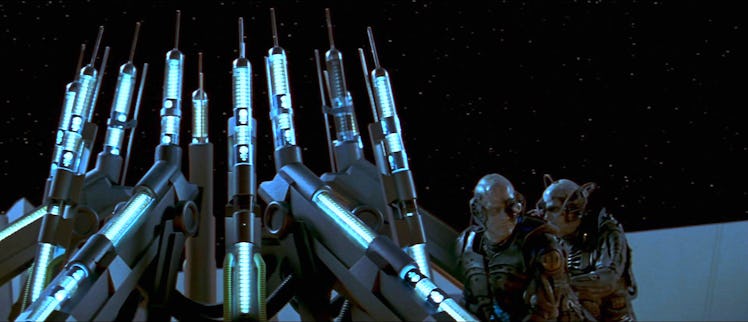
Time-traveling Borg from 2373 trying to contact other Borg from 2063.
Where are the Borg in 2024?
In the Star Trek canon, the Borg are not from the future. In First Contact, when the Borg traveled back from 2373 to 2063, they attempted to contact other contemporary Borg, who were at that time still only living in the Delta Quadrant. In Star Trek’s past there are Borg alive in 20th and 21st centuries, but they’re not anywhere near Earth.
Now the existence of Jurati’s new time-traveling Borg Queen seems to imply there are two Borg Queens alive in 2024. One is living somewhere in the Delta Quadrant running the old collective, and this new Queen is a fusion of two people from different versions of 2401. In theory, there were probably two Borg Queens around in First Contact’s 2063 too for the same reason: Time travel.
At the end of the episode, the Jurati Borg Queen leaves Earth with the La Sirena (a ship also from an alternate 2401) to go in search of the Borg of this time period. This is huge, and most likely won’t be retconned.
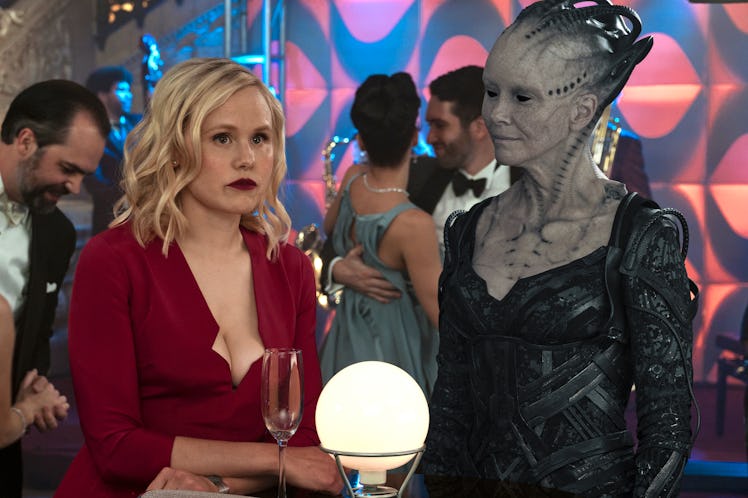
Jurati and the Borg Queen have a discussion in her mind in Picard Episode 6, “Two of One.”
How Jurati’s Borg Queen changes Star Trek canon
Assuming the hooded Borg Queen we saw in “The Star Gazer” is also the Jurati Borg Queen, only several centuries later, it would seem like an entirely different version of the Borg rose up in some kind of alternate timeline created by Picard and the crew coming back to 2024. Ironically, Picard and the gang travelled to 2024 to prevent a different alternate timeline from getting created in the first place.
Confused? That’s understandable. In “The Star Gazer” we’re told a fancy new Borg ship punched a hole in spacetime. Whether that’s time travel or a bridge between parallel dimensions, there are potentially three timelines at play here:
- The regular Picard timeline we see at the beginning of “The Star Gazer.”
- The evil Confederation timeline from Episode 2, “Penance,” which is the departure point for the crew’s trip to Earth’s past.
- Possibly a new “friendly Borg” timeline, in which Jurati reforms the Borg in the 21st century.
This last possibility, which seems probable, means that in one version of Earth’s past the Borg become good .
If true, what will that mean for the “Prime” Star Trek canon? Will Picard Season 2 end with some kind of hybrid timeline in which people have memories of two types of Borg? And presumably Jean-Luc and the crew will need to get back to the 25th century, but Jurati just stole their ride . S o however Jean-Luc returns to his present, history as we know it will have been altered.
Star Trek: Picard Season 2 airs its finale on May 5, 2022, on Paramount+.

This article was originally published on April 29, 2022
- Science Fiction

30 Best Star Trek Characters, Ranked
Space, the final frontier…
Incredibly, Star Trek has been part of our lives for nearly 60 years, ever since the original series (or TOS in Trek lingo) premiered on CBS on Sept. 8, 1966. And in the nearly six decades since, 12 series and 13 films — not to mention untold numbers of books, video games and merch galore! — have expanded upon Gene Roddenberry’s vision of a better future for mankind and all species capable of interstellar travel.
So, who are the “best” Star Trek characters from across that plethora of media? So glad you asked as, from the hundreds of individual characters that have boldly gone the distance to be established in the pop culture firmament, we’ve chosen the top 30 for your enjoyment. And for our purposes, we’re keeping it to humanoid characters, hence why V’Ger, the sentient machine from “Star Trek: The Motion Picture,” won’t be making an appearance.
Let the discussion begin!
30. Borg Queen
No. of appearances: 8 (7 episodes and 1 film)
Known for: Trying to take over Picard’s ship in two different timelines
Note: Film counts are inclusive of J.J. Abrams’s alternate “Kelvin timeline” that commenced with the 2009 “Star Trek” film.
Why Borg Queen Is One of the Best
The Borg was set up in several “Next Generation” episodes as a hive mind collective organism — an uber-unified symbiotic being that engulfed the consciousness and intelligence of all species it conquered. However, screenwriters Brannon Braga and Ronald D. Moore altered the discussion somewhat for 1996’s “Star Trek: First Contact,” in which the Borg goes back in time to prevent mankind from developing warp capabilities. When Picard and Co. go through the time portal, too, the new Enterprise-E is gradually taken over by the Borg, and Picard soon comes face to face with the Borg Queen, the personification of the techno-villains.
The Queen was played by Australian actress Alice Krige in “First Contact” and in several episodes of “Voyager,” but the late Annie Wersching, who sadly succumbed to cancer, portrayed a new queen on Season 2 of “Picard.”
29. Wesley Crusher
No. of appearances: 70 (69 episodes and 1 film)
Known for: Coming of age on the Enterprise-D and going off with the Traveler
Why Wesley Crusher Is One of the Best
Depending on who you ask, Wesley Crusher was either the worst part of “The Next Generation” or a sadly overly bullied punching bag of Trek angst. Actor Wil Wheaton, known for “Stand By Me,” was all of 15 when he came aboard the Enterprise-D in 1987 as Dr. Beverly Crusher’s fatherless son.
Over the course of the show, Wes grew and changed from awkward teen into a confident young man at the helm of the starship. Wesley eventually went off on a journey beyond time and space with the being known as the Traveler; though, somehow, he still showed up in “Star Trek: Nemesis” at Riker and Troi’s wedding … though he had no speaking lines.
In the ultimate cultural revenge, nerds are cool now, and Wheaton not only embraces the legacy of Wesley Crusher, but he’s also shown up on “The Big Bang Theory” and even brews his own beer . Nerds rule!
No. of episodes: 21
Known for: Annoying Picard, changing shape, making the TNG cast play “games”
Why Q Is One of the Best
The puckish Q is a powerful being of seemingly unlimited abilities, which he put to use several times against Picard and his crew. However, Q’s games typically weren’t malicious, and often his little tricks proved illuminating — such as when he allowed Picard to see himself in an alternate universe where he never captained the Enterprise. Every time Q magically appeared on the bridge of the Enterprise, you knew you were in for some fun.
While Qs don’t age, human actors do, and thus when John de Lancie showed up for Season 2 of “Picard” in 2022, there was “that moment” when he gazes upon an aging Picard, then clicks his fingers to “catch up” to Picard’s age at the dawn of the 25th century. (De Lancie was de-aged to his TNG-era physicality for the “before” effect.)
27. Seven of Nine
No. of episodes: 115
Known for: Trying to find her human roots after being separated from the Borg
Why Seven of Nine Is One of the Best
Let’s face it, “Voyager” was a bit stale in those middle seasons. Enter Seven of Nine, a human female Janeway and crew rescued from the Borg who became part of the Voyager crew’s decades-long quest to return to Earth. Seven of Nine’s appearances on both “Voyager” and “Picard” have allowed the writers to explore the anguish of what happens when a human is unplugged from the warm embrace of the Borg collective.
Jeri Ryan has brought gravitas to Seven since her introduction in 1997 … and, because Star Trek is typically targeted at boys and men, there's no shortage of sex appeal either.
No. of episodes: 173
Known for: Running the best damn pub in space; hoarding gold-pressed latinum
Why Quark Is One of the Best
“Deep Space Nine” dealt with heavy subjects like interspecies war, xenophobia and the trauma of losing one’s spouse to the Borg, so some comic relief was definitely in order. The barkeep Quark was always there with a dry quip as he poured a cocktail, but don’t turn your back on him for too long, as the Ferengi was usually figuring out how to fleece his customers out of their money.
Actor Armin Shimerman was always hilarious as the scheming publican, which may be why the good folks at Paramount set up “Quark’s Bar” at the “Star Trek: The Experience” at the Las Vegas Hilton in 1998. But don’t go boldly in search of that Sin City attraction, as the entire “Experience” closed for good in 2008. Bah!
25. Miles O’Brien
No. of episodes: 67
Known for: Being the Enterprise-D’s and DS9’s transporter chief
Why Miles O’Brien Is One of the Best
For proof positive that a “hey, it’s that guy!” actor can make the jump to the main stage, we present Colm Meaney, whose Chief O’Brien was in charge of the transporter room on the Enterprise-D before beaming down to Deep Space Nine in 1993 as chief of operations.
O’Brien was notable for being more than a stock character, and Meaney truly brought this brainiac to life on both TNG and DS9 over his dozen years appearing within the Trek universe.
RELATED: 25 Recognizable Celebrities You Know but Can't Name
24. Ro Laren
No. of episodes: 8
Known for: Being a Bajoran Federation member before defecting to the Maquis
Why Ro Laren Is One of the Best
It’s a difficult path to navigate a character with dual loyalties, but actress Michelle Forbes imbued the Bajoran Ro Laren with nuance and sympathy. She was heroic in her work aboard the Enterprise-D, which included acting as a spy to infiltrate the Maquis, a Bajoran underground movement whose campaign aimed at removing the Cardassian occupation of their homeland.
However, Picard’s plan to use Ro as a spy was too clever by half, as she decided to join the insurgency in her final TNG appearance. Goes to show that, even in the 24th century, people still wrestle with their consciousness.
23. Elim Garak
No. of episodes: 33
Known for: Living in exile aboard Deep Space Nine

Why Elim Garak Is One of the Best
One of the joys of DS9 was the ongoing relationship between Garak and Dr. Julian Bashir — kind of like an outer space version of “can’t we all just get along?” However, as the only Cardassian still living aboard the space station, Garak raised many a Federation eyebrow as to what he was really up to. Though he’d been exiled from Cardassia, several people on the station still believed he was up to no good.
Actor Andrew Robinson created a truly fascinating, multilayered character in Garak, and you were never quite sure whether to love him or hate him. But he kept you watching!
No. of appearances: 18 (14 episodes and 4 films)
Known for: Being Vulcan’s ambassador to Earth and Spock’s dad
Why Sarek Is One of the Best
Mark Lenard was great in his various appearances as Sarek, from the original show (TOS) to TNG and three films. (Ben Cross played a younger Sarek in the “alternative” J.J. Abrams movie timeline in 2009’s “Star Trek.”) Not only was Sarek an intelligent and canny diplomat, but marrying Amanda Grayson, a human, allowed Sarek to be more informed about human affairs during his many years as Vulcan’s ambassador to Earth. Oh, and of course, he helped his half-human son, Spock, learn the ways of his father’s world while navigating the strangeness of human emotions.
Fun fact: Mark Lenard also showed up in “Star Trek: The Motion Picture” as the commander of the Klingon ship that gets vaporized by V’ger.
Known for: Being chief of security aboard Deep Space Nine
Why Odo Is One of the Best
Because Odo was a changeling, he could shapeshift into nearly anything, which gave him a rather convenient way of keeping tabs on what was going on aboard DS9 for all those years. However, Odo had the unfortunate necessity of reverting to a liquid form to “recharge” on a daily basis, which made life for this character rather interesting.
Actor René Auberjonois personified icy coolness in portraying Odo, and it’s hard to imagine the space station without this Star Trek character around.
No. of appearances: 36 (34 episodes and 2 films)
Known for: Tending bar at Ten Forward, always with a kind word
Why Guinan Is One of the Best
What do you mean you forgot that Whoopi Goldberg was on TNG and “Picard”? Thankfully, we’re here with a reminder that long before she co-hosted “The View” in New York, Goldberg was working Los Angeles sound stages portraying the El-Aurian bartender Guinan in the Ten Forward lounge.
The TNG writers cleverly keep Guinan’s backstory mysterious, gradually unveiling that her homeworld had been conquered by the Borg, and most of her people were murdered. Guinan also had extra-sensory perceptions that helped out in such situations as realizing that the Enterprise-D had fallen into an alternate timeline in the classic episode “Yesterday’s Enterprise.” Empathetic yet remote, Guinan was a key part of the TNG success formula.
19. Dr. Beverly Crusher
No. of appearances: 166 (162 episodes and 4 films)
Known for: Being the Enterprise-D’s chief medical officer
Why Beverly Crusher Is One of the Best
Dr. Crusher had a complicated history with Captain Picard, considering that her husband Jack was killed during a mission Picard led while serving aboard the Stargazer years before the events of TNG. This always imbued their relationship with awkwardness and guilt, particularly as Picard slowly became a surrogate father figure to Crusher’s son, Wesley.
Gates McFadden lent Dr. Crusher a rather unique mix of gravitas, professionalism and vulnerability — and was so likable that her exit from the show during the second season was short-lived due to fan outcry. (Remember her replacement, Dr. Pulaski? Yeah, neither do we.)
18. Deanna Troi
No. of appearances: 188 (185 episodes and 4 films)
Known for: Being the Enterprise-D’s onboard counselor
Why Deanna Troi Is One of the Best
TNG introduced us to several new species beyond the Klingons, Vulcans and Romulans of TOS, including the Betazed, a race of psychic telepaths. This made them empathetic and nurturing, which may be why, in a bid to get away from the cowboy mythos of TOS, Gene Roddenberry included Deanna Troi as the ship’s counselor for the Enterprise-D.
It sounds like a thankless role, but Marina Sirtis truly made Troi a fully realized character, and her anguished acting in the episode where she temporarily loses her psychic abilities is masterful.
17. Jadzia Dax
No. of episodes: 148
Known for: Hosting her Trill symbiont
Why Jadzia Dax Is One of the Best
Trills are an interplanetary species of little wormlike creatures who must “host” inside another being in order to function. Thus, when Jadzia Dax (Terry Farrell) stepped aboard Deep Space Nine during the pilot episode, she was actually the eighth host for the Trill Dax. Jadzia Dax was the first female host body the Trill had used in some time, which led to a bit of a learning curve on the show … and later tragedy.
Jadzia Dax married Worf following his tour of duty on the Enterprise-D, but her host body was killed during DS9’s Dominion War storyline (Farrell claimed she left the show due to clashes with producer Rick Berman). Thus, the moral quandaries posed by Star Trek continue, and nobody was more caught up in them than this character.
16. Kira Nerys
No. of episodes: 174
Known for: Acting as Bajoran liaison officer on Deep Space Nine before later assuming command
Why Kira Nerys Is One of the Best
Things got off to a rocky start for Kira and Benjamin Sisco on the DS9 pilot, as the Bajoran wasn’t precisely keen on a human Starfleet bureaucrat becoming her new boss. However, over the course of the show, Kira and Sisco developed a mutual respect, particularly when the Dominion War threatened the entire galaxy. Kira provided no quarter for nonsense, and her no-guff style of leadership and warrior mentality made her both feared and respected among the denizens of Deep Space Nine.
In case you are missing seeing her, you can actually catch Kira in a single episode of “Lower Decks” from fall 2022.
15. Kathryn Janeway
No. of appearances: 188 episodes and 1 film
Known for: Commanding the USS Voyager on its journey from the Delta Quadrant back toward Earth
Why Kathryn Janeway Is One of the Best
When the Voyager found itself stranded on the far side of the galaxy, Captain Janeway (Kate Mulgrew) had a difficult choice to make: commission Maquis rebels into her Starfleet-led crew, or almost certainly never make it back to Earth without their help.
As quality leaders do, she made the best decision, and thus the Voyager commenced its 35,000-light-year trip back to Federation space in Alpha Quadrant (spoiler alert: thanks to some help in the finale, they made it home about 60 years ahead of schedule). It wasn’t all smooth sailing for the Voyager, but Janeway was always a steady hand at the helm.
14. Pavel Chekov
No. of appearances: 45 (36 episodes and 9 films)
Known for: Navigating the Enterprise under Captain Kirk
Why Pavel Chekhov Is One of the Best
Gene Roddenberry created Star Trek at the height of the Cold War when relations between Washington and Moscow were rather frosty. Thus, adding Russian navigator Pavel Chekov (Walter Koenig) to the cast in Season 2 lent faith to his vision of a brighter world of tomorrow, in which humans had finally conquered all war and famine back on Earth.
That was rather forward-thinking for the mid-1960s, with the Vietnam War raging, but fans immediately warmed to Chekov, who has been a part of Kirk’s crew over the decades.
13. Nyota Uhura
No. of appearances: 104 (95 episodes and 9 films)
Known for: Making sure everyone on the Enterprise stays connected
Why Nyota Uhura Is One of the Best
Isn’t it annoying when your cell phone signal drops? Try mastering communications from deep space, which was part of Uhura’s job description on the Enterprise. Think of her as an outer space operator among the stars.
Beyond the character’s attributes, it’s undeniable that representation has always been one of the most amazing things about the Star Trek universe. It wasn’t typical to have an ethnically mixed cast at the time of TOS, so Roddenberry again used outer space of the future to address racism on contemporary Earth. The late Nichelle Nichols was actually planning to leave the show when she received an unexpected visit from the Rev. Dr. Martin Luther King Jr., who encouraged her to stay aboard the Enterprise to be “seen” by the American public at large. (Perhaps it’s no coincidence that “Uhuru” translates to “freedom” in the Swahili language.)
12. Geordi La Forge
No. of appearances: 194 (191 episodes and 4 films)
Known for: Somehow seeing more than those of us with “real” human eyes
Why Geordi La Forge Is One of the Best
Any organization is only as good as its IT and engineering department. For the Enterprise-D, the big cheese of problem-solving was none other than Geordi La Forge, for whom no problem where an interspace-blaster-reverse-proton-thingamagig needed a quick fix was too big to handle. In addition to his technical know-how, Geordi was calm under pressure and kindly, which may be why he was so popular with other senior staff of the Enterprise.
And showing what a pro he was, LeVar Burton did double duty on “Reading Rainbow” during his entire run on TNG. The beloved actor and host is widely credited with encouraging kids of all ages — especially those of color — to learn to love reading.
11. Hikaru Sulu
No. of appearances: 81 (72 episodes and 9 films)
Known for: Getting drunk and running around with a saber … and other things, too
Why Hikaru Sulu Is One of the Best
Sulu might not have gotten as much backstory as the other members of the original Enterprise crew, but thankfully George Takei was able to turn on the charm (“oh my!”) in the big-screen films — especially by “Star Trek VI: The Undiscovered Country” when he’d made it all the way to the captain’s chair of the Excelsior.
However, everyone probably remembers Sulu for that time on TOS when he went crazy and ran around shirtless with a saber because, you know, reasons. It was such a Trek-ism that it even became the reason behind Kelvin-timeline Sulu (John Cho) being absolutely ninja-level with a sword in the 2009 “Star Trek” movie.
10. Benjamin Sisko
Known for: Keeping the peace aboard Deep Space Nine
Why Benjamin Sisko Is One of the Best
Talk about a dark backstory! Sisko’s wife was killed at the Battle of Wolf 359, where the Borg destroyed an entire fleet of Federation starships. The Borg was able to claim such a victory due to assimilating Captain Picard, who as Locutus effectively got behind Starfleet security protocols. Thus, when Sisko was tapped to command Deep Space Nine, whom should he run into but none other than Picard! Understandably, even though he had long since been removed from the Borg collective, Sisko was nowhere close to trusting Picard. And that was just in the DS9 pilot!
Over the seven seasons of the show, Sisko evolved as both commander and diplomat — and made a valiant, selfless choice in the finale episode for the greater good. Here’s to you, Sisko!
No. of appearances: 98 (88 episodes and 10 films)
Known for: Fixing just about everything
Why Scotty Is One of the Best
Being Scottish, Montgomery Scott was fond of dropping many an “aye” into his conversations with Kirk and the gang. And it’s a good thing he always answered in the affirmative, as the good captain tossed all sorts of problems Scotty’s way to solve. Remember when they went back in time to 20th-century San Francisco to fetch whales? Guess who was tasked with building a whale tank to warehouse the beasts on their time travel back to the 23rd century!
In one of the most fascinating TNG episodes, “Relics,” Scotty was rescued from a transporter loop by Captain Picard, which led to some both hilarious and sad moments as the engineer tried to tackle 24th-century gadgets and gizmos. It was a really cool way to bridge the worlds of classic Trek and TNG.
No. of appearances: 287 (283 episodes and 4 films)
Known for: Being the first Klingon to graduate Starfleet Academy
Why Worf Is One of the Best
Worf broke many a barrier — and quite a lot of other things along the way, being a Klingon warrior and all. He became the first member of his species to serve aboard a Federation starship and quickly rose to chief of security on the Enterprise-D following the death of Tasha Yar (Denise Crosby).
Worf’s having been adopted by humans led to many intriguing storylines over the years, as he connected with his Klingon heritage, and his arc was expanded when he joined the cast of “Deep Space Nine” in 1995 for the last four seasons.
No. of appearances: 187 (183 episodes and 4 films)
Known for: Having no emotions at all … until he did
Why Data Is One of the Best
Like Worf, Data cracked through more than a few barriers on his ascent to operations officer aboard the Enterprise-D. Having an android on the crew was super handy, as Data could perform insanely complex computations at lightning speed and outthink most any carbon-based lifeform. The one thing he couldn’t do, however, was laugh or cry or be scared. That is, until an emotion chip was introduced into the TNG storyline, which allowed Data to be more like his human colleagues than ever before … and he even dropped a swear word or two for comic measure.
Brent Spiner also portrayed Data’s evil alter-ego Lore and the creator of both, Dr. Soong, throughout the Trek world. Data and Lore also returned for various storylines on “Picard.”
6. Dr. McCoy
No. of appearances: 105 (96 episodes and 9 films)
Known for: Dispensing cranky Southern wit while patching up wounds
Why Dr. McCoy Is One of the Best
Was there ever a more crabby Trek character than Leonard McCoy? Bones always seemed like he wanted to be anywhere but tending the Enterprise’s walking and not-walking wounded, which led to much of the humor on TOS and the Trek movies.
His relationship with emotionless Spock, whom he called a “green-blooded hobgoblin,” added awesome laughter to the series and films — much of that credit due to the late DeForest Kelley. And mad kudos to Australian actor Karl Urban, who has done more than a yeoman’s job taking over the role in the Kelvin timeline.
5. Will Riker
No. of appearances: 192 (188 episodes and 4 films)
Known for: Acting as the steady second-in-command of the Enterprise-D and Enterprise-E
Why Will Riker Is One of the Best
Riker had that magical combination of intelligence, moxy, toughness and attractiveness that made him an incredibly effective senior member of the Enterprise crew. Oh, and don’t forget his many, many love affairs over the years, most notably with Counselor Troi, with whom he reconnected romantically in the film series and finally married in “Star Trek: Nemesis.”
That last film in the TNG canon finally finally finally (did we say finally yet?) saw Riker promoted to the rank of captain and getting his own ship at long last. But that didn’t stop him from showing up to help out his old buddy Jean-Luc in Season 1 of “Picard” and boards that final voyage with the admiral for Season 3.
No. of appearances: 3 (1 episode and 2 films)
Known for: Getting his hands on as many doomsday weapons as possible
Why Khan Is One of the Best
Khan Noonien Singh was awakened from hypersleep by Kirk in the classic TOS episode “Space Seed,” where the supercriminal promptly tried to take over the Enterprise. His plans foiled, Khan and his genetically engineered acolytes were banished to Ceti Alpha V, which turned into a nightmare when nearby Ceti Alpha VI exploded and made their own planet all but uninhabitable … making Khan rather thirsty for some “wrath,” as it were.
While there have been a great many villains over the years of Trek, none has been as extreme, as deliciously awful or as memorable as Khan.
No. of appearances: 91 (82 episodes plus 9 movies)
Known for: Acting in a highly logical fashion most of the time
Why Spock Is One of the Best
He started out as science officer of the Enterprise, then retired to Vulcan, then un-retired when V’Ger came around, then was promoted to captain, then died, then was resurrected, then retired from Starfleet again, then became Vulcan’s ambassador to Earth, then got sucked into a black hole that sent him into the alternate Kelvin timeline. (There will be a test.)
Spock did it all, and he was ever unflappable — even when wrestling with his human emotions on more than one occasion. The genius of Spock was how he was, as his father Sarek observed in the 2009 film, “a child of two worlds,” never quite feeling at home as either human or Vulcan. Leonard Nimoy truly brought Spock to wondrous life in the four decades he played the character, who will always be one of the true miracles of the Trek universe.
1. James Kirk and Jean-Luc Picard (Tie)
Kirk No. of appearances: 114 (104 episodes and 10 films)
Picard No. of appearances: 208 (204 episodes and 4 films)
Known for: Being the best two captains to ever take the helm of a starship
Why Kirk and Picard Are the Best
Some things are just not worth arguing over. Coke or Pepsi. Burger King or McDonald’s. Dick Sargent’s or Dick York’s Darrin on “Bewitched.” Mayonnaise or Miracle Whip. Dan or Dave .
Kirk or Picard.
The two most famous captains from the Star Trek universe are so different that it’s pretty much impossible to describe one as “better” than the other … though that hasn’t stopped Trekkies, Trekkers and even casual fans from fighting over it for more than 35 years now. James T. Kirk was brash, shoot-from-the-hip, fond of bending the rules when it suited him, yet unfailingly loyal — the classic cowboy of outer space. Meanwhile, Jean-Luc Picard was a by-the-books kind of leader, intelligent and introspective, but never failing at a moment of crisis when true authority was needed. They both had their flaws and their benefits, and we cheered them on no matter the adventure. The two met only once in “Star Trek Generations,” which required them to put their heads together to defeat a common enemy.
Kirk and Picard have been Trek's most important, most consistent characters over more than half a century. It was so cool to see a younger Kirk in the Kelvin timeline played by Chris Pine, but to us, Kirk and William Shatner will always be synonymous. And thanks to the third and final season of “Picard,” we got to ride with Patrick Stewart as the old admiral for one final voyage.
No matter which was your favorite captain, both Kirk and Picard have taken us boldly to the final frontier on so many adventures.
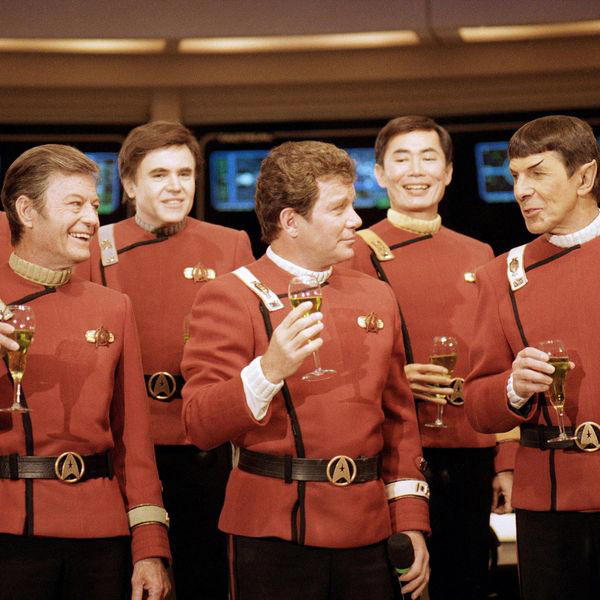
Flickering Myth
Geek Culture | Movies, TV, Comic Books & Video Games
Comic Book Preview – Star Trek: Defiant #14
April 21, 2024 by Gary Collinson
IDW Publishing releases Star Trek: Defiant #14 on Wednesday, and we have the official preview of the issue for you below; check it out…
Resistance is futile! Cornered by their own parasitically possessed crewmate, Worf and the Defiant crew scramble for a way to safely save her before it’s too late. But the hive is eager to grow its numbers, seeking total dominance over a galactic level of organic species after already claiming Starbase 99’s crew as hosts. Trapped and unable to call Starfleet for assistance, Hugh suggests taking drastic measures-assimilate B’Elanna to Borg tech!
Star Trek: Defiant #14 is out on Wednesday, April 24th.
About Gary Collinson
Gary Collinson is a film, television and digital content producer and writer, who is the founder of the pop culture website FlickeringMyth.com and producer of the upcoming gothic horror feature film 'The Baby in the Basket'. He has over 20 years of experience within the industry, including a decade of teaching and lecturing in film and media, and is the author of the book 'Holy Franchise, Batman! Bringing the Caped Crusader to the Screen'.
YOU MIGHT ALSO LIKE:
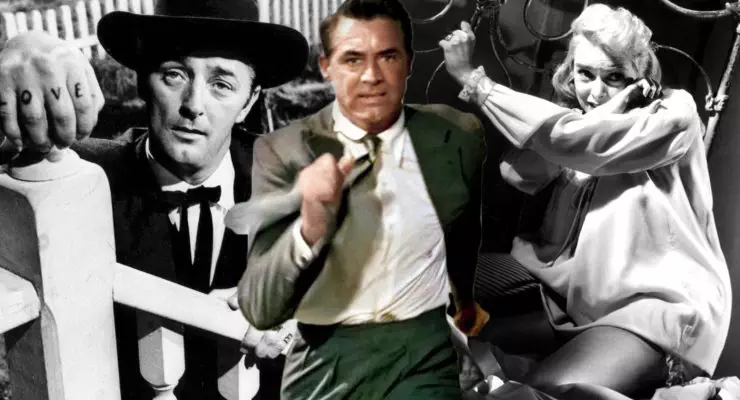
Ten Essential Films of the 1950s
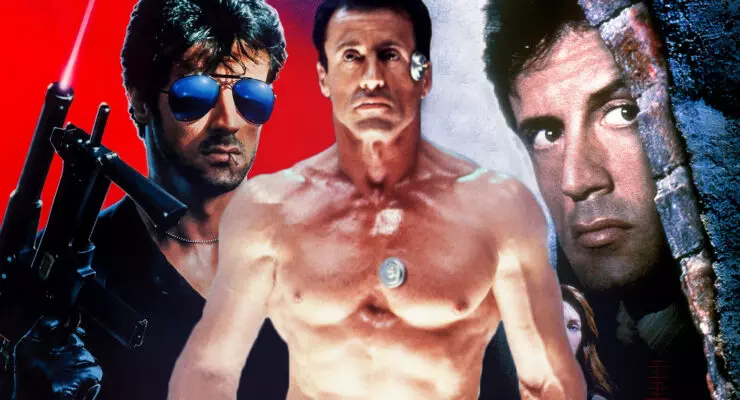
Five More Sylvester Stallone Movies That Need a Sequel After Cliffhanger
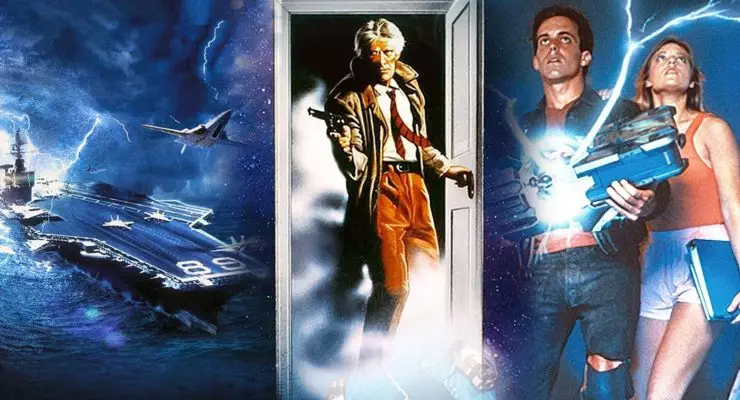
10 Underrated Time Travel Movies from the 1980s
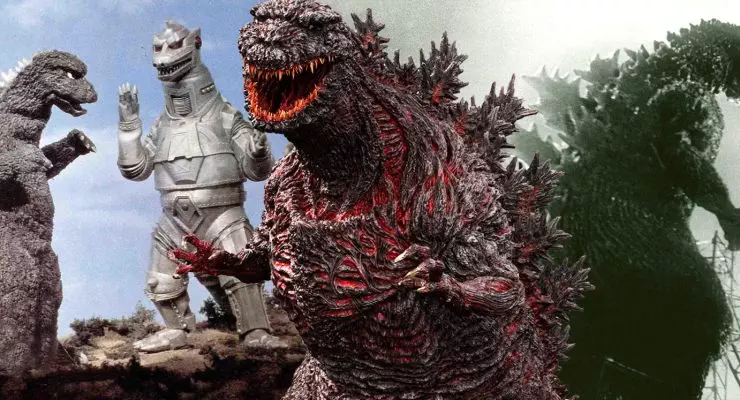
Godzilla Minus One and the Essential Toho Godzilla Movies

All Game of Thrones Spinoffs Beyond House of the Dragon Explained
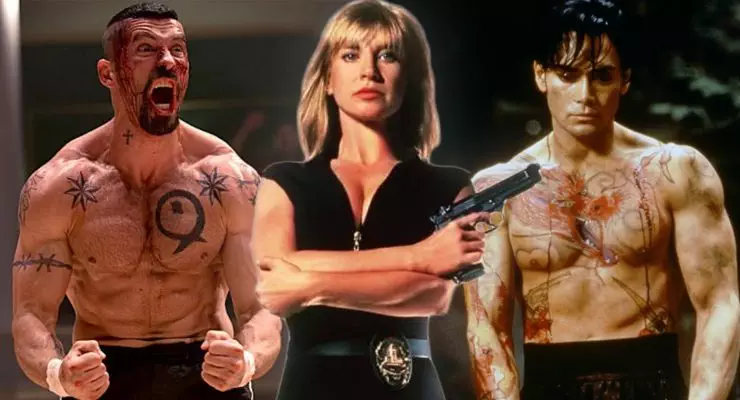
Underappreciated Action Stars Who Deserve More Love

Forgotten 90s Thrillers You Have To See
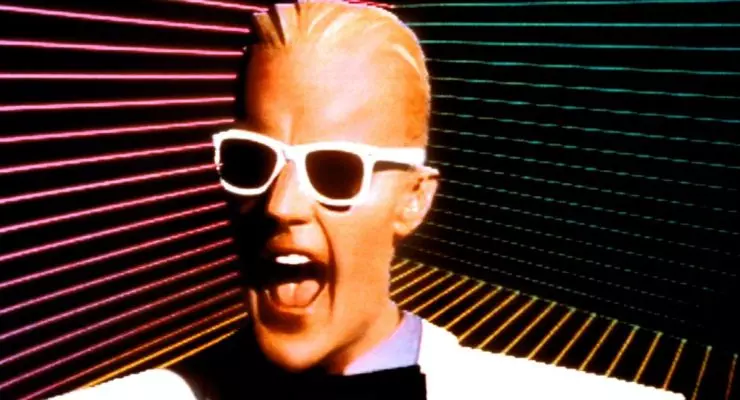
Max Headroom: The Story Behind the 80s A.I. Icon
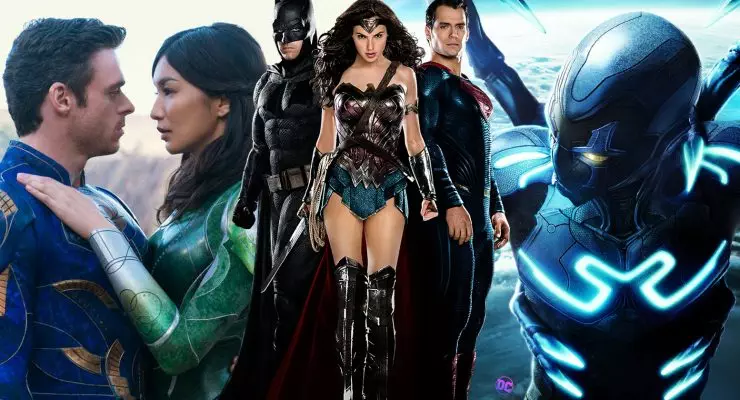
The Most Overhated Modern Superhero Movies

20 Essential Criterion Collection Films
- Comic Books
- Video Games
- Toys & Collectibles
- Articles and Opinions
- About Flickering Myth
- Write for Flickering Myth
- Advertise on Flickering Myth
- Terms of Use
- Privacy Policy
Screen Rant
12 star trek female villains ranked, worst to best.
Star Trek has a long list of female villains that have faced off against Kirk, Picard, Janeway, and Sisko, but who's the best at being the worst?
- The best Star Trek female villains include complex characters like the Intendant and the Female Changeling.
- The Female Romulan Commander and Alixus offer early examples of intriguing female villains in Star Trek.
- While some female villains like the Borg Queen excel, others like Seska from Voyager fall short of their potential.
While the canon of iconic Star Trek antagonists can often feel like an exclusive boy's club, many of the franchise's best villains have been complex female characters. For nearly 60 years, many of the best known villains in Star Trek movies and TV shows have been male, from Khan Noonien Singh (Ricardo Montalban) to Shinzon (Tom Hardy). Looking back, it feels quite regressive, and speaks to a wider issue with how women were written in early Star Trek .
For example, the notorious Star Trek: The Original Series finale "Turnabout Intruder" features Dr. Janice Lester (Sandra Smith), who was presented as a hysterical woman scorned, rather than a multi-layered and complex villain. However, even in those early days, there were one or two memorable female villains that could hold their own against Captain James T. Kirk (William Shatner). While Star Trek 's movie villains have been predominantly male, the TV shows of the 1990s and 2020s introduced some truly iconic recurring female villains to the franchise .
Every Major Star Trek Villain Species, Ranked
12 alixus (gail strickland), star trek: ds9, season 2, episode 15, "paradise".
The impact of Alixus (Gail Strickland) is relatively minor. However, Alixus is an incredibly compelling Star Trek: Deep Space Nine villain who deserves to sit alongside some franchise greats. In DS9 season 2, episode 15, "Paradise", Commander Benjamin Sisko (Avery Brooks) and Chief Miles O'Brien (Colm Meaney) are stranded on a planet that has abandoned technology in favor of a more simple life. Alixus is the leader of this traditionalist community, but Sisko and O'Brien soon unearth the darkness at its core. Alixus was a Federation scientist who had theorized that a return to nature would be better for humanity in the long run.
Gail Strickland had previously appeared with Avery Brooks in Spenser: For Hire .
To prove her point, she sabotaged the colony ship, the SS Santa Maria, forcing it to crash-land on a remote planet. Alixus installed a duonetic field generator that prevented all technology from operating, forcing the colonists to live by her new vision. To prove her thesis, she resorted to cruel punishments and stood by and let her colonists die from easily curable ailments. Gail Strickland plays Alixys with such nuance, transforming "Paradise" from a filler episode into an underrated Star Trek: Deep Space Nine classic . Her electric scenes with Sisko foreshadow the DS9 captain's later conflicts with other zealots.
Star Trek: Deep Space Nine
*Availability in US
Not available
Star Trek: Deep Space Nine, also known as DS9, is the fourth series in the long-running Sci-Fi franchise, Star Trek. DS9 was created by Rick Berman and Michael Piller, and stars Avery Brooks, René Auberjonois, Terry Farrell, and Cirroc Lofton. This particular series follows a group of individuals in a space station near a planet called Bajor.
11 Seska (Martha Hackett)
Star trek: voyager, seasons 1 to 3.
Star Trek: Voyager 's Seska (Martha Hackett) was a fantastic idea for a character, but very poorly executed. Introduced as one of the secondary Maquis crew members of the Valjean, it quickly became clear that Seska was hiding something. Not only did Seska want Commander Chakotay (Robert Beltran) to lead a mutiny against Captain Kathryn Janeway (Kate Mulgrew), she was also a Cardassian spy in disguise. These two elements combined ended up confusing Seska's character in Voyager , as an outnumbered Cardassian would surely have set their sights on an alliance with Janeway, not the Maquis .
Martha Hackett previously played the Romulan Sub-commander T'Rul in Star Trek: Deep Space Nine 's season 3 premiere "The Search, Parts I & II".
Eventually, Seska left the USS Voyager, to make an alliance with the Kazon in an attempt to capture the ship. The motivations for Seska's plan to capture Voyager were seemingly rooted in her disappointment at being scorned by her former lover, Chakotay. Disappointingly, one of Star Trek: Voyager 's most interesting villains was reduced to the level of Captain Kirk's evil ex-girlfriend, Janice Lester . The most successful plot by Seska was only discovered after she'd died, when a holodeck simulation of a Maquis mutiny turned into a deadly trap in Voyager season 3, episode 25, "Worst Case Scenario".
Star Trek: Voyager
The fifth entry in the Star Trek franchise, Star Trek: Voyager, is a sci-fi series that sees the crew of the USS Voyager on a long journey back to their home after finding themselves stranded at the far ends of the Milky Way Galaxy. Led by Captain Kathryn Janeway, the series follows the crew as they embark through truly uncharted areas of space, with new species, friends, foes, and mysteries to solve as they wrestle with the politics of a crew in a situation they've never faced before.
10 Asencia, The Vindicator (Jameela Jamil)
Star trek: prodigy season 1.
Janeway's ship was once again infiltrated by an enemy alien in Star Trek: Prodigy season 1. Masquerading as a Trill ensign, Asencia helped track the USS Protostar, in the hopes of activating its deadly Living Construct weapon and destroying Starfleet. Asencia's true identity was discovered after Janeway and the USS Dauntless rescued the Diviner (John Noble). Hoping that the two Vau N'AKat could work together, Asencia was shocked when the Diviner chose his daughter Gwyndala (Ella Purnell) over their plan to destroy Starfleet. In the Prodigy season 1 finale, Asencia successfully activated the Living Construct and returned to her own time .
Asencia's story will presumably continue in Star Trek: Prodigy season 2 , as Admiral Janeway heads into the alternate future to rescue Captain Chakotay and his crew from the Vau N'Akat. It's therefore hard to rank Asencia higher until her story plays out in full. However, judging by the ruthlessness and cunning that Asencia displayed in Prodigy season 1, it's clear that Janeway and the crew of the USS Voyager-A will have their work cut out for them.
Star Trek: Prodigy
Star Trek: Prodigy is the first TV series in the Star Trek franchise marketed toward children, and one of the few animated series in the franchise. The story follows a group of young aliens who find a stolen Starfleet ship and use it to escape from the Tars Lamora prison colony where they are all held captive. Working together with the help of a holographic Captain Kathryn Janeway (Kate Mulgrew), the new crew of the USS Protostar must find their way back to the Alpha Quadrant to warn the Federation of the deadly threat that is pursuing them.
9 Female Romulan Commander (Joanne Linville)
Star trek: the original series, season 3, episode 4, "the enterprise incident".
In Star Trek: The Original Series , season 2, episode 4, "The Enterprise Incident", Captain Kirk is tasked with stealing a Romulan cloaking device . Part of the plan requires Lt. Commander Spock (Leonard Nimoy) to seduce an unnamed Female Romulan Commander (Joanna Linville), who is attracted to the Vulcan. However, unlike Seska in Star Trek: Voyager , the Female Romulan Commander's ambitions lie far beyond romantic interests. She believes that capturing the USS Enterprise for the Romulan Star Empire will be a boon for her career progression, and wants Spock to serve alongside her.
Years after the events of "The Enterprise Incident", the Federation was banned from developing cloaking technology thanks to the Treaty of Algeron.
Having seemingly turned on Kirk and even killed him in a fight, Spock keeps the Female Romulan Commander interested while Kirk infiltrates the ship. However, the Commander saw through the ruse and beamed aboard the Enterprise to try and take it by force, or have it destroyed. The plan to steal the USS Enterprise is foiled, and the Female Romulan Commander is left embarrassed by falling for Kirk and Spock's fight and losing the cloaking device to the Federation. Interestingly, Spock doesn't throw the Female Romulan Commander into the brig, and instead takes her to standard quarters, implying his seduction wasn't all pretend.
Star Trek: The Original Series
Star Trek: The Original Series follows the exploits of the crew of the USS Enterprise. On a five-year mission to explore uncharted space, Captain James T. Kirk (William Shatner) must trust his crew - Spock (Leonard Nimoy), Dr. Leonard "Bones" McCoy (Forest DeKelley), Montgomery "Scotty" Scott (James Doohan), Uhura (Nichelle Nichols), Chekov (Walter Koenig) and Sulu (George Takei) - with his life. Facing previously undiscovered life forms and civilizations and representing humanity among the stars on behalf of Starfleet and the United Federation of Planets, the Enterprise regularly comes up against impossible odds and diplomatic dilemmas.
8 Lursa and B'Etor Duras (Barbara March and Gwynyth Walsh)
Star trek: tng, ds9 and star trek generations.
The House of Duras were sworn enemies of Worf, Son of Mogh (Michael Dorn) in Star Trek: The Next Generation and Star Trek: Deep Space Nine . After Worf killed the House's patriarch in TNG season 4, episode 7, "Reunion", Duras' sisters Lursa (Barbara March) and B'Etor (Gwynyth Walsh) were left seeking vengeance. The House of Duras tried to instigate a Klingon Civil War, and even provided a Bajoran terrorist with the explosives needed to destroy the wormhole in DS9 season 1. Following the aborted Klingon Civil War, the Duras sisters effectively became guns for hire, placing them in the orbit of Dr. Tolian Soren (Malcolm McDowell) in Star Trek Generations .
Star Trek Generations was a disappointing end for the Duras Sisters, as they never really got a final confrontation with Worf . Sidelined as Soran's muscle, the sisters and their Klingon crew did manage to destroy the USS Enterprise-D, but their own ship was destroyed soon after. Weirdly, Generations never lingered on what a big deal this would have been for Worf, given how the House of Duras had been behind many of his issues with the Klingon Empire. This dissatisfying ending means that the Duras Sisters can't make it into the top tier of female Star Trek villains.
Star Trek: The Next Generation
Star Trek: The Next Generation is the third installment in the sci-fi franchise and follows the adventures of Captain Jean-Luc Picard and the crew members of the USS Enterprise. Set around one hundred years after the original series, Picard and his crew travel through the galaxy in largely self-contained episodes exploring the crew dynamics and their own political discourse. The series also had several overarching plots that would develop over the course of the isolated episodes, with four films released in tandem with the series to further some of these story elements.
7 Sela (Denise Crosby)
Star trek: the next generation, "redemption" and "unification".
Sela was the Romulan daughter of Tasha Yar (Denise Crosby), who spent years working for the intelligence services. Sela's first notable operations against the Federation were brainwashing Lt. Geordi La Forge (LeVar Burton) to assassinate Klingon governor Vagh (Edward Wiley) in the Star Trek: The Next Generation episode "The Mind's Eye". Sela tried again to destabilize relations between the Klingon Empire and the Federation when she supported the Duras Sisters' attempt to take control of the Klingon Empire. Sela's plans were foiled by Captain Picard and a Starfleet armada that prevented Romulan reinforcements from entering Klingon space .
Denise Crosby conceived the character of Sela as a means to return to Star Trek: The Next Generation after enjoying the experience of making "Yesterday's Enterprise".
Sela became the mastermind behind an attempted Romulan invasion of Vulcan, by manipulating Ambassador Spock's reunification mission. Using a holographic duplicate of Spock, Sela hoped to convince the Federation that an incoming fleet of Vulcan ships contained a Romulan peace envoy, and not an invasion force. Picard, Data, and Spock foiled Sela's plan, and she was incapacitated with a Vulcan nerve pinch, never to be heard from again. It was an ignominious end for Star Trek: The Next Generation 's best Romulan villain.
Spock’s Star Trek TOS Romance Explains His TNG Vulcan & Romulan Dream
6 valeris (kim cattrall), star trek vi: the undiscovered country.
Lt. Valeris (Kim Cattrall) is a great Star Trek villain because there's a genuine emotional impact on the crew of the USS Enterprise-A. It may have been better if Saavik betrayed Spock in Star Trek VI: The Undiscovered Country , but the weight of Valeris' betrayal is still impactful. Valeris' cold Vulcan logic dictated that peace with the Klingons was illogical , which is why she joined the Khitomer Conspiracy. Spock's protégé helped to frame Captain Kirk and Dr. McCoy (DeForest Kelley) for political assassination, and deliberately hindered the investigation.
While Gene Roddenberry objected to her inclusion, Saavik was actually written out of Star Trek VI: The Undiscovered Country because Kirstie Alley declined to return to the role.
Valeris' coldness makes her quite a compelling Star Trek villain, as she genuinely believes her many crimes are based on logic. It's a fascinating insight into how interpretations of logic can differ from Vulcan to Vulcan, as proved by Spock and Valeris' clash in Star Trek VI: The Undiscovered Country . Interrogated by Kirk and forced to endure a controversial mind meld with Spock, Valeris finally revealed the identities of the conspirators, and was taken to the Khitomer Conference to publicly unmask the conspiracy.
5 Vadic (Amanda Plummer)
Star trek: picard season 3.
Vadic was one of the most unpredictable foes ever faced by Admiral Jean-Luc Picard. A Changeling tasked with delivering Jack Crusher (Ed Speleers) to the Borg Queen (Alice Krige), Vadic took some big swings to achieve her goals in Star Trek: Picard season 3. Vadic's awesome ship, the Shrike, almost destroyed the USS Titan-A and its crew during their multiple skirmishes in the course of Picard season 3 . Vadic even found time to kidnap Counselor Deanna Troi (Marina Sirtis) in an attempt to secure the assistance of Captain William T Riker (Jonathan Frakes).
Amanda Plummer is the daughter of Christopher Plummer, who played the villainous General Chang in Star Trek VI: The Undiscovered Country .
It's a testament to Amanda Plummer's unique portrayal of a Star Trek villain that it wasn't immediately clear that Vadic was a Changeling . The scenes in "Dominion" in which Vadic described the brutal treatment of Changeling prisoners during the Dominion War were beautifully performed by Plummer, adding depth to Star Trek: Picard season 3's villain . It even elicited a degree of sympathy, but Vadic soon lost that when she began executing members of the USS Titan-A's crew. Eventually, she was blown out into space by Jack Crasher, where, ironically, her Changeling body solidified then exploded into pieces.
Star Trek: Picard
After starring in Star Trek: The Next Generation for seven seasons and various other Star Trek projects, Patrick Stewart is back as Jean-Luc Picard. Star Trek: Picard focuses on a retired Picard who is living on his family vineyard as he struggles to cope with the death of Data and the destruction of Romulus. But before too long, Picard is pulled back into the action. The series also brings back fan-favorite characters from the Star Trek franchise, such as Seven of Nine (Jeri Ryan), Geordi La Forge (LeVar Burton), Worf (Michael Dorn), and William Riker (Jonathan Frakes).
4 The Intendant (Nana Visitor)
Star trek: deep space nine (various).
The Intendant, the Mirror Universe variant of Major Kira Nerys (Nana Visitor) is one of Star Trek: Deep Space Nine 's most memorable villains. DS9 brought back the Mirror Universe in a big way, and the Intendant played a key role in each return visit. Kira's dark opposite was effectively the Gul Dukat of the Mirror Universe's Terok Nor, ruling the station with intimidation, manipulation, and violence. She was assisted in her tyrannical role of the station by Elim Garak (Andrew Robinson), who opposed some of the Intendant's more holistic methods .
Star Trek: Deep Space Nine producer Michael Piller had been rejecting Mirror Universe episodes since his days on Star Trek: The Next Generation . However, he and Ira Steven Behr finally figured out that the most interesting story to tell would be the aftermath of the fall of the Terran Empire, as seen in DS9 's Mirror Universe episodes.
The Intendant eventually lost control over the Terran rebels, thanks to various Mirror Universe incursions by Kira and Captain Sisko . This led to her losing her position, and being imprisoned aboard Regent Worf's flagship in Star Trek: Deep Space Nine season 7. Hoping to win favor with Worf, the Intendant orchestrated a plot to have the flagship fitted with a stolen cloaking device. However, the cloak was sabotaged, leaving the flagship open to attack from the Terran rebels, striking another blow against the Klingon-Cardassian Alliance, and giving the former Intendant a chance to escape with her life.
3 Kai Winn (Louise Fletcher)
Kai Winn (Louise Fletcher) was one of Star Trek: Deep Space Nine 's most fascinating characters. First introduced in the DS9 season 1 finale, Vedek Winn was a religious zealot who objected to Sisko's closeness to the Bajoran Prophets. This jealousy of Sisko eventually poisoned the calculating religious leader even further, pushing her to more and more extreme lengths to bring herself closer to her gods. Played by Oscar winning actress Louise Fletcher , Kai Winn's descent into hell across seven seasons of DS9 was compulsive viewing.
Louise Fletcher and Michelle Yeoh are the only two Star Trek stars to win the Academy Award for Best Actress.
While Kai Winn had a redemption of sorts in Star Trek: Deep Space Nine 's finale, it was still rooted in the cowardice and pettiness of her character. When she realized that the Pah wraiths wanted Gul Dukat as their emissary and not her, she decided to put her faith back in Sisko. While that saved Bajor from destruction, it's hard to ignore that Kai Winn's motivations were once again rooted in Bajor's higher beings ignoring her.
2 The Female Changeling (Salome Jens)
The Female Changeling (Salome Jens) was Star Trek: Deep Space Nine 's most interesting female villain . The spokesperson for the Dominion Founders, she was a master manipulator, and a steely villain with little regard for the "solids". The Female Changeling's attempts to manipulate Constable Odo (René Auberjonois) were compelling viewing, and ultimately solidified the Constable's loyalty to his friends aboard DS9. Seen as a god by the Vorta, the Female Changeling also appeared to delight in manipulating Weyoun (Jeffrey Combs) by playing him off against the Breen in the latter stages of DS9 's Dominion War .
Salome Jens also played the First Humanoid, now referred to as a Progenitor, in the Star Trek: The Next Generation episode, "The Chase", which Star Trek: Discovery season 5 is a sequel to.
Salome Jens' performance as the Female Changeling was utterly compelling, delivering her lines with an icy sense of superiority befitting a species that set themselves up as gods. When the Dominion War ended in the Star Trek: Deep Space Nine finale, the Female Changeling was taken into custody for her multiple war crimes. However, despite Odo's attempts to educate his people to move past the Female Changeling's ideology, those like Vadic still wanted to destroy the Solids following the Dominion War.
1 The Borg Queen (Alice Krige)
Star trek: first contact, voyager, picard.
Introduced in Star Trek: First Contact , the Borg Queen (Alice Krige) is the greatest female villain that the franchise has produced . Unlike her drones, Star Trek 's Borg Queen had a personality, and used that to seduce others into joining the Collective. Lt. Commander Data (Brent Spiner) seemingly fell under the Borg Queen's spell in First Contact , but was merely distracting her so he could avert the Collective's plan to sabotage the Phoenix's first warp flight. The Borg Queen's consciousness was stored elsewhere, able to be downloaded into a new body, which is why other actress have played the role originated by Krige.
Each Borg Queen performer has brought something new to the character, the most notable being Annie Wersching and Alison Pill's partnership in Star Trek: Picard season 2 . Their co-dependent relationship revealed new information about the Borg Queen that humanized her somewhat. Through her connection to the Queen, Dr. Agnes Jurati (Alison Pill) discovered that the Borg long for connection, and the Queen is ultimately lonely. Rather than being a retcon, this was a callback to the Queen's previous relationships with Data and Picard, confirming that they were the only matches for Star Trek 's most enduring female villain.
Star Trek: First Contact is available to stream on Max.

IMAGES
VIDEO
COMMENTS
The Borg Queen was the name of the entity that existed within and served as the queen of the Borg Collective. An ancient being, the Queen has existed for many hundreds of years. (Star Trek: First Contact; PIC: "Surrender") In the event of her body's destruction, she would appear to be reincarnated with her personality and memories intact. (Star Trek: First Contact; VOY: "Dark Frontier ...
The Borg Queen is the leader of the Borg Collective, a fusion of organic and synthetic matter that seeks to assimilate all life forms. Learn about her history, personality, and role in Star Trek: First Contact, Voyager, and Picard.
A list of every Borg Queen in Star Trek, from the First Contact movie to the Picard series. Each Borg Queen has a brief description of their personality, appearance, and role in the franchise. The Borg Queen is the central nexus of the Borg Collective and has different memories and memories from each incarnation.
Ms. Wersching was best known for playing the Borg Queen on the Paramount+ "Star Trek" series. She was also on the television series "24," "Bosch" and "Timeless."
Learn how the Borg Queen became a legendary villain in Star Trek, from her origin in First Contact to her final fate in Picard season 3. Discover the actors who played her, the timelines she appeared in, and the controversies she caused.
1997's Star Trek: First Contact establishes several updates to the Borg which carried over into later series, including Picard. They have the ability to assimilate via retractable cybernetic ...
The Borg Queen seen in Star Trek Picard season 3 is the Borg Queen seen in Star Trek First Contact. She is the Borg Queen who assimilated Jean-Luc Picard and turned him into Locutus of Borg, and who Picard defeated with the plasma coolant when he destroyed her living parts. However, the Borg Queen survived this by absorbing the life force of ...
Resistance is futile. Or, in the case of the new Borg Queen in at least one timeline of Star Trek: Picard Season 2, resistance is optional.. In the second episode of Season 2, "Penance," we ...
Nevertheless, the Borg Queen assimilated another day, returning for episodes of Voyager and Lower Decks. In season 2 of Picard she's back once again. In the final moments of the season opener ...
Alice Krige made such an indelible impression as the sinewy, sexy and sinister Borg Queen in Star Trek: First Contact that the character remains one the greatest Trek villains of all time. Krige later reprised the role in the Voyager series finale, "Endgame," and provided her voice for both the game Star Trek: Armada II and the Borg Invasion 4-D short at the Star Trek: Experience ...
The Borg Queen is living in Alison Pill's brain. By the end of Star Trek: Picard Season 2 Episode 6, "Two of One," Dr. Agnes Jurati (Alison Pill) and the Borg Queen (Annie Wersching) have ...
Alice Krige at the 11th Annual Official Star Trek Convention in 2021. In Lower Decks, Season 2, Episode 8, "I, Excretus," Boimler ( Jack Quaid) finds himself in a holographic drill where he ...
Warning: SPOILERS for Star Trek: Picard Season 1, Episode 6. Star Trek: Picard episode 6 revealed new Borg technology that explains how the Borg Queen manages to escape each time she's defeated. Kicking off the second half Star Trek: Picard season 1, Jean-Luc Picard (Patrick Stewart) finally came face-to-face with Soji Asha (Isa Briones), the synthetic daughter of the late Commander Data ...
The existence of the Borg Queen was a controversial change made to the Borg during the writing of Star Trek: First Contact. While the writers had intended to stay true to the original concept of the Borg as a collective hive, they found it difficult to maintain the dramatic impact of villains without having a central face.
Data (Brent Spiner), who was abducted by the Borgs, meets with the Borg Queen (Alice Krige). Eager to learn more about the Borgs, he asks her a few questions...
The first was created aboard a Borg Cube in Sector 10. The creation process was, however, halted by the crew of the USS Enterprise -E a short time after coming online. ( TNG novel: Resistance) Later, the Borg would capture and assimilate Admiral Kathryn Janeway - making her into a replacement Queen.
The Borg are an alien group that appear as recurring antagonists in the Star Trek fictional universe. The Borg are cybernetic organisms (cyborgs) linked in a hive mind called "The Collective." The Borg co-opt the technology and knowledge of other alien species to the Collective through the process of "assimilation": forcibly transforming individual beings into "drones" by injecting nanoprobes ...
The Borg Queen is loose in the 21st century. At the end of Star Trek: Picard Season 2, Episode 9, "Hide and Seek," Jean-Luc and what's left of his motley crew are still trapped in the past ...
The Borg Queen is played by Australian actress Jane Edwina Seymour in Star Trek: Picard season 3's final two episodes. Seymour is now the fifth actress to portray the Borg Queen, although there was also The Face (voiced by Garth Kemp), the visage Captain Vadic (Amanda Plummer) communicated with in Picard season 3, who was tacitly revealed to be the Borg Queen all along.
The Borg and their origins in Star Trek explained. The Borg are a cybernetically enhanced collective of various species, all assimilated into a single hive mind. Other than the Borg Queen (as well as rare exceptions like Hugh and ex-Borg like Seven of Nine), there were no single individuals within the Borg.
Star Trek's Borg Queen has remained a controversial character since her introduction in Star Trek: First Contact. 1996's First Contact was the second of four films starring the cast of Star Trek: The Next Generation, and the plot revolved around Captain Jean-Luc Picard and crew traveling back to the year 2063 to stop a group of time-traveling Borg from preventing humanity's first contact with ...
Borg Queen. No. of appearances: 8 ... Film counts are inclusive of J.J. Abrams's alternate "Kelvin timeline" that commenced with the 2009 "Star Trek" film. Why Borg Queen Is One of the Best.
Alice Krige returns as the Borg Queen in Star Trek: Lower Decks, the animated series that follows the adventures of the USS Enterprise-D's new crew. She explains why she's back despite Annie Wersching playing her in Star Trek: Picard. The Borg Queen is a controversial and iconic villain who has menaced Picard and Janeway in different incarnations.
Trapped and unable to call Starfleet for assistance, Hugh suggests taking drastic measures-assimilate B'Elanna to Borg tech! Star Trek: Defiant #14 is out on Wednesday, April 24th.
The Exact Origin Of The Borg Are Unknown. While they originated from the Delta Quadrant, the actual history of the species known as the Borg was quite spotty in Star Trek canon. During the events of 1996's Star Trek: First Contact the Borg Queen mentioned that the species started as normal sentient life but had eventually adapted using ...
The best Star Trek female villains include complex characters like the Intendant and the Female Changeling. The Female Romulan Commander and Alixus offer early examples of intriguing female villains in Star Trek. While some female villains like the Borg Queen excel, others like Seska from Voyager fall short of their potential.